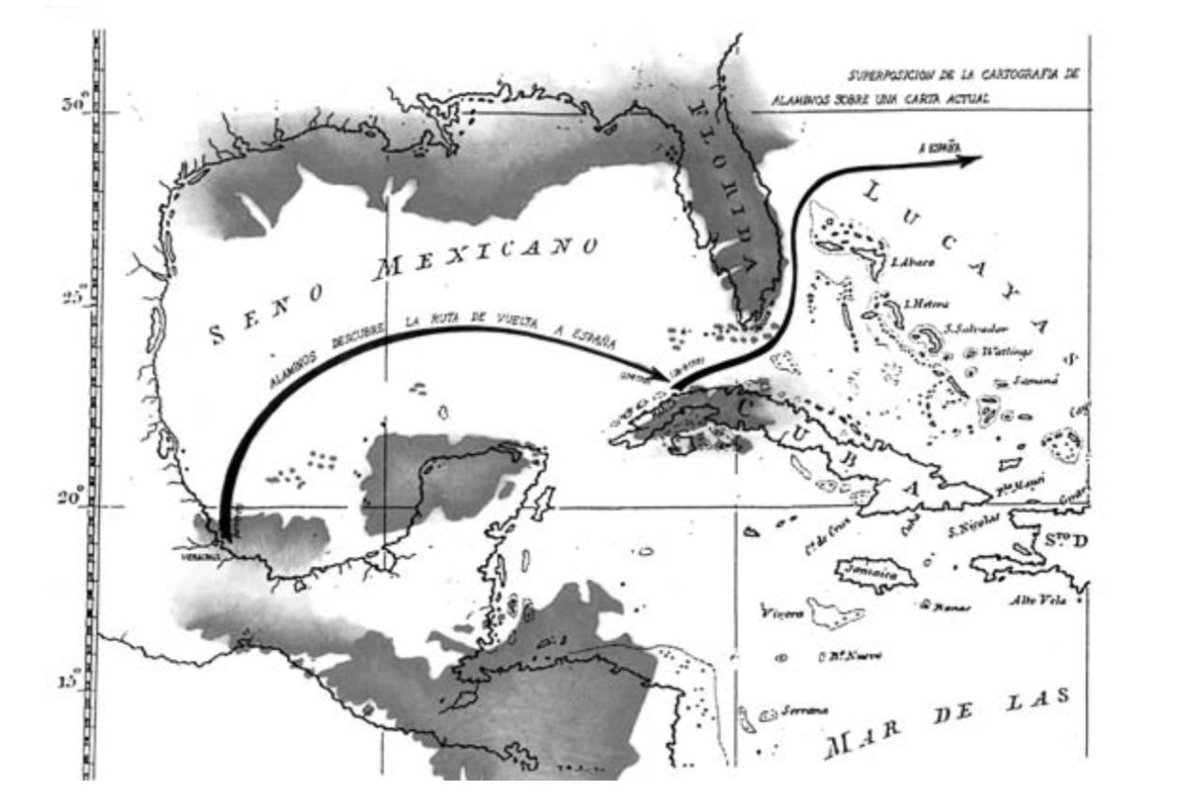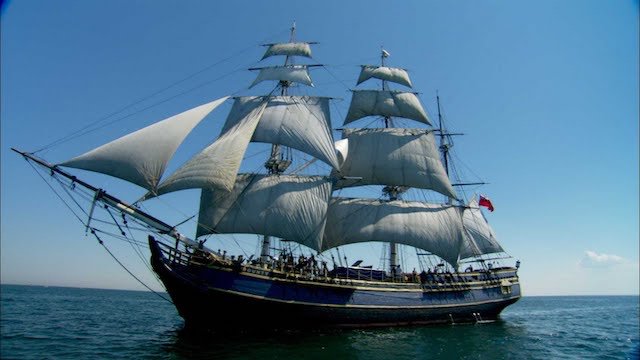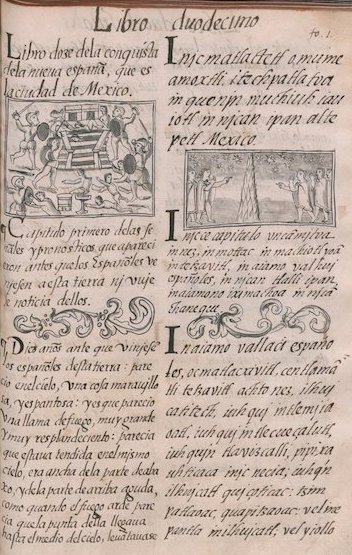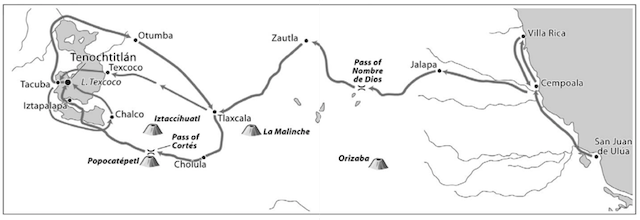1519 Timeline from 10 February (leaving Cuba to Yucatan) to 16 August (leaving Veracruz to Tenochtitlan)
10 February 1519
Hernan Cortes sails for Mexico with 11 ships, 508 soldiers, about 100 sailors, six cannons, and 16 horses. The expedition set out from Santiago, Cuba, on 18 November 1518. He finished fitting out at Trinidad and S. Cristobal de la Habana
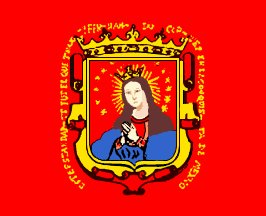
Women were prohibited from embarking. However, mulatto Fabiana was an exception, and some soldiers traveled with their spouses, and five more women, who used to live amongst soldiers
Hernan Cortes was 34 years old in 1519. In the expedition to Mexico there were 300 indigenous antillean, and two blacks, Tadeo and Roberto, Juan Sedeño‘s servant. Many were massacred by acolhuas in Zultépec in 1520
Months later, Gonzalo de Sandoval with 15 horsemen and 200 infantry arrived to Zultépec when about 550 expedition members had already been massacred in one by one sacrifices. After destruction, a new place was built: Tecoaque ‘the place where lords were devoured’
Watch video Aztec Massacre. History Documentary hosted by Jay Sanders, published by PBS broadcasted as part of PBS Secrets of the Dead series in 2016 (See program transcript)
11 captains: Alonso de Ávila, Diego de Ordás, Francisco de Morla, Francisco de Montejo, Francisco de Saucedo, Juan de Escalante, Juan Velázquez de León, Cristóbal de Olid, Pedro de Alvarado, Alonso Hernández de Portocarrero, and Gonzalo de Sandoval. And Francisco de Orozco captain of artillery and Antón de Alaminos main pilot
15 February 1519
Pedro Menéndez de Avilés was born in Avilés, Spain. He was a Spanish admiral and explorer who is remembered for planning the first regular trans-oceanic convoys and for founding St. Augustine, Florida, in 1565. This was the first successful Spanish settlement in La Florida and the most significant city in the region for nearly three centuries. St. Augustine is the oldest continuously-inhabited, European-established settlement in the continental United States. Menéndez de Avilés was also the first governor of Florida (1565–74)
17 February 1519
Hernan Cortes expedition arrived on the island of Cozumel. Earlier Spanish expeditions had talked of some Christians stranded there, so saving those Christians was one of the orders Cortes had received from Cuban governor Diego Velazquez

First ship to arrive was the San Sebastian, that had missed the starting meeting point in Cuba. Cortés arrived two days later. Upset, he imprisoned Camacho, pilot, for a short period of time and admonished Alvarado, captain, for stealing aliments and women
Having sail with big storms that dispersed the fleet, one ship did not arrived to Cozumel (Santa Cruz): it was the one with Alonso de Escobar as captain and pilot Juan Alvarez el Cojo, This ship was found some days later in Puerto Deseado, near Cabo Catoche
The pilots and about one third of expedition members knew Yucatan coast from previous trips, mainly the one with Grijalva in April 1518, in which the pilot was also Antón de Alaminos. Grijalva was killed by natives in Honduras on 21 January 1527
Alaminos story is also very sad: on July 26th, 1519 Cortés sent him back to Spain piloting Nuestra Señora de la Concepción with the first relation letter and presents to emperor Charles V. Arriving to Sanlúcar in October 1519. the ship was captured in Seville
Diego Velázquez, the governor of Cuba whom Cortés had desobeyed, had successfully manoeuvred to get the ship, Alaminos and two procurers (Francisco de Montejo and Alonso Hernández Portocarrero) captured: Portocarrero died in prison and Alaminos some time later
18 February 1519
Cozumel inhabitants had fled inland. They were Mayan subjugated by the Aztec Triple Alliance. Cortés found a temple dedicated to the goddess of rainbow, Ix Chel, in ancient Maya culture the name of the aged jaguar goddess of midwifery & medicine

Cortés also found another surprise: tons of ‘books’. They were beautiful drawings on the inner bark of some trees (specially fig trees), smeared with bitumen and stretched to form papyrus several meters long (amatl https://bit.ly/2tqtw74 )
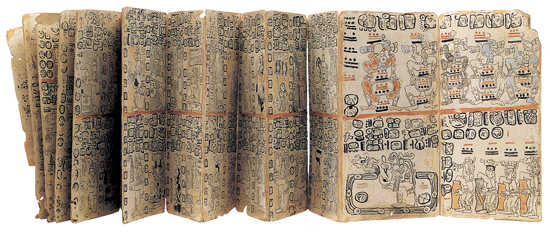
Cortés found a woman with her children and servants. He asked her to get people back, promising to be well treated. After that, he ordered Alvarado to give them back everything robbed from their houses. In exchange, the chief gave Spaniards fish, bread and honey
This encounter between two worlds had started and from now on everything changed for Aztecs and for Spain. Events could have continued with a withdrawal of Cortés or the founding of factories near the coast, but Spaniards were not only seeking for riches and fame
19 February 1519
For the first time, Cortés addressed locals to tell them that human sacrifices were hateful and when they asked what law to obey he told them that there was a God who created heaven and earth, the giver of all things

20 February 1519
Mayans informed Cortés that beyond the island, in Yucatan, there were two Christian captives for several years. Cortés sent 50 men in two brigantines. A man brought a message hidden in his hair with news of Cortés arrival with 550 spaniards.
“Dear Sirs and Brothers, Here, on the island of Cozumel, I received information that you are detained prisoners by a cazique. I beg of you to come here to me on the island of Cozumel. To this end I have sent out an armed ship, and ransom-money, should it be required by the Indians. I have ordered the vessel to remain stationary off the promontory of Cotoche for eight days, to wait for you. Come as speedily as possible; you may depend upon being honorably treated by me. I am here with eleven vessels armed with 500 soldiers, and intend, with the aid of the Almighty and your assistance, to proceed to a place called Tabasco, or Potonchon; etc.”

21 February 1519
Cortés is waiting for Juan de Escalante and Diego de Ordás return with Spaniards prisoners: two men living there for years would be of great help as interpreters, since Melchorejo (or Julianillo) had limited knowledge of Spanish
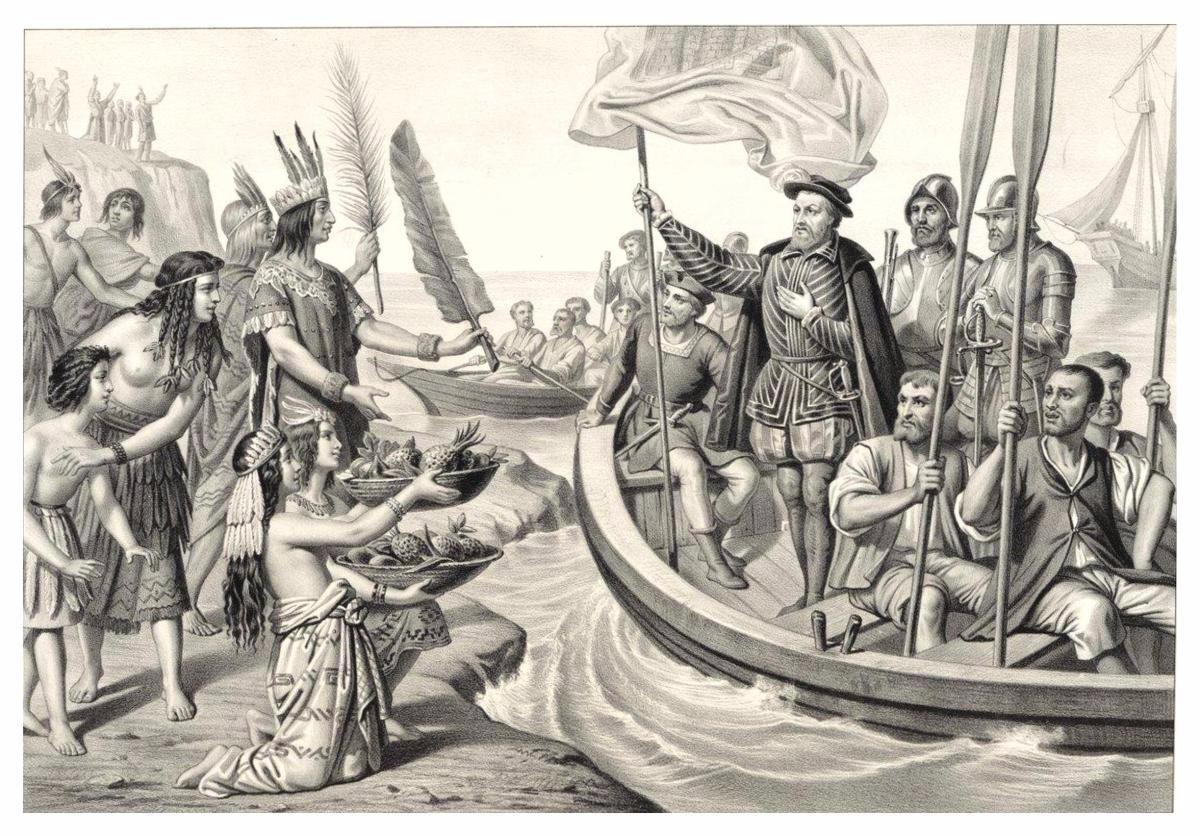
Melchorejo was one of the Aztec interpreters of Cortés until he was replaced by Aguilar and Malintzin. He ended up on the side of the Aztecs whom he incited to fight against the Spaniards. Later he was sacrificed to the gods, following one defeat of the Aztecs
22 February 1519
The name of prisoners were Jeronimo de Aguilar and Gonzalo Guerrero. Eight years before they were shipwrecked near Yucatan, arrived to the coast with other 12 survivors, were captured by the local Maya and scheduled to be sacrificed to Maya gods
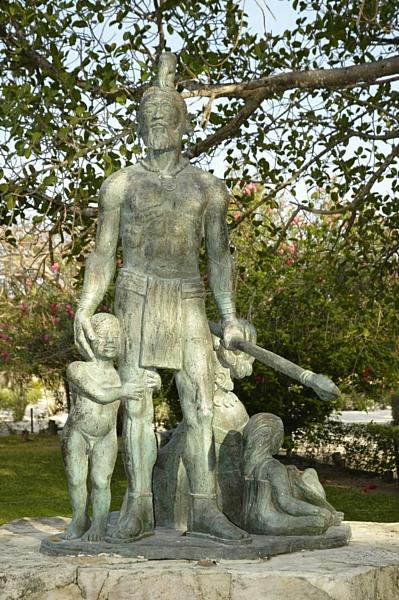
Aguilar was a Franciscan friar born in Écija, Guerrero a sailor from Palos de la Frontera both in Spain. Both managed to escape, later to be taken as slaves by another Maya chief named Xamanzana who was hostile to the first tribe. They learned the Maya language
Aguilar lived as a slave. His continued fidelity to his religious vows led him to refuse the offers of women made to him. Guerrero became a war chief for Nachan Kaan, lord of Chektumal, married a rich Maya woman and fathered the first mestizo children of Mexico
Following Bernal Diaz, when Aguilar met Guerrero to tell him about the Cortés’ offer to join him, Guerrero refused saying: ‘Brother Aguilar, I am married and have three children, and they look on me as a cacique (lord) here, and captain in time of war. My face is tattooed and my ears are pierced. What would the Spaniards say about me if they saw me like this? Go and God’s blessing be with you, for you have seen how handsome these children of mine are. Please give me some of those beads you have brought to give to them and I will tell them that my brothers have sent them from my own country’
23 February 1519
Cortés urged Mayan in Cozumel to renounce human sacrifice and replace their idols with images of the Virgin Mary. The Spanish revulsion at human sacrifice was not a justification: this attitude is typical of many Catholics in this period
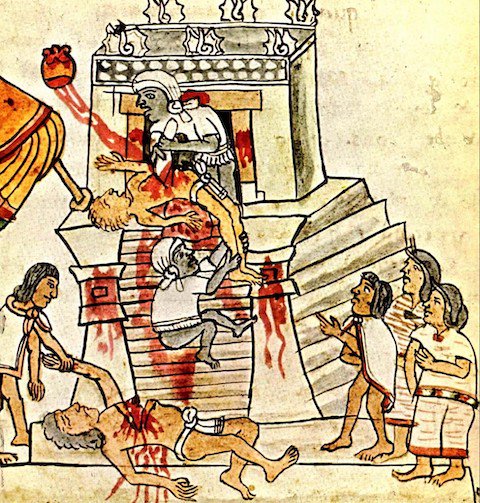
(Five hundred years later)
One of the worst epidemics in human history, a sixteenth-century pestilence that devastated Mexico’s native population, may have been caused by a deadly form of salmonella from Europe, a pair of studies suggest https://go.nature.com/2NogO1W
24 February 1519
Mayans and Spaniards relations were good. Cortés spoke often about the convenience of accepting Carlos V as sovereign. The Mayans were impressed by the beards and the skin of the Spaniards, They did not show them their horses, that being secret arms, remained on the ships
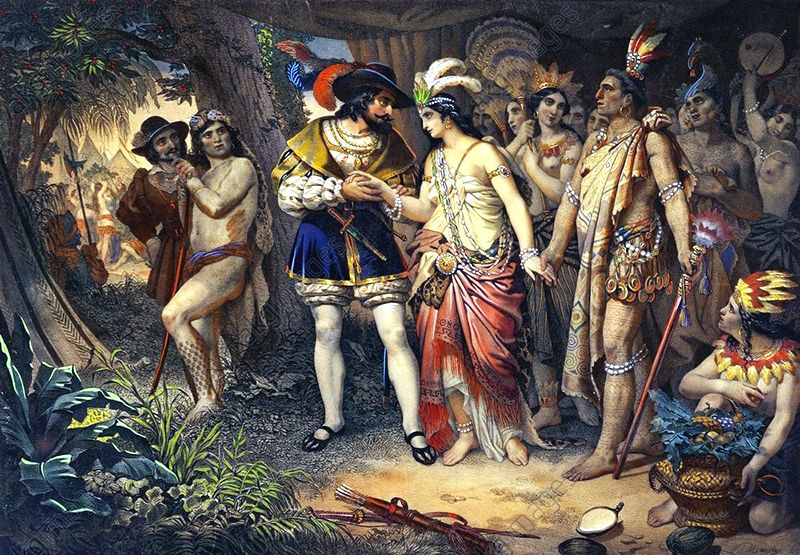
25 February 1519
Cortes’ expedition had a complex legal status in Spain. Limited orders from Governor Velazquez, who had himself many restrictions to explore, as lieutenant of Diego Colon in Cuba, the son of Columbus, and the only rights’ owner to populate land
In fact, in the same days, Velazquez was expecting a royal privilege from Spain to populate, and Cortes could not do anything against royal orders if they arrived before his departure or knew about it. Cortes transformed this situation into his great opportunity
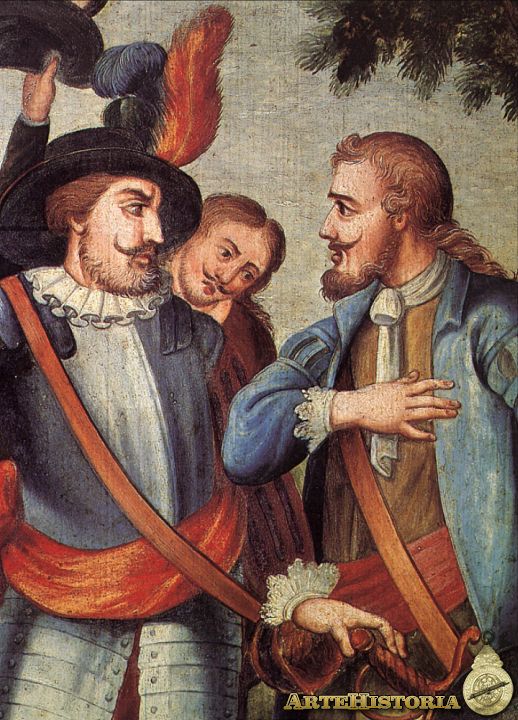
26 February 1519
Seeing that the captive Spaniards did not come, nor the Mayans who had come to look for them, it was agreed to return with the two brigantines to island of Cozumel (Santa Cruz); and arrived at the island and news was received with great sorrow

27 February 1519
Cortes said to Diego de Ordas, with great vehemence, he expected he would have fulfilled his commission better than to return without the Spaniards, and even without bringing him any information respecting them
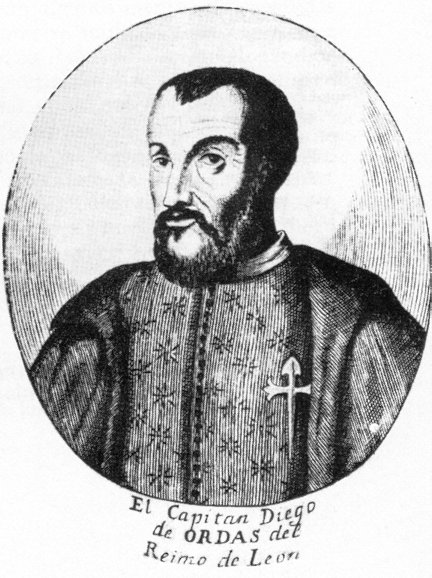
28 February 1519
The island of Cozumel, says Bernal Diaz del Castillo, ‘was a place to which the Indians made pilgrimages (…) in great numbers to sacrifice to some abominable idols, which stood in a temple there.’
‘One morning (…) that the place where these horrible images stood was crowded with Indians (…) They burnt a species of resin, which very much resembled our incense, and as such a sight was so novel to us we paid particular attention to all that went forward’
‘Upon this an old man, who had on a wide cloak and was a priest, mounted to the very top of the temple, and began preaching something to the Indians. We were all very curious to know what the purport of this sermon was (…)’
‘(…) Cortes ordered the caziques, with the principal men among them and the priest, into his presence, giving them to understand (…) by means of our interpreter, that if they were desirous of becoming our brethren they must give up sacrificing to these idols’
‘which were no gods but evil beings, by which they were led into error and their souls sent to hell. He then presented them with the image of the Virgin Mary and a cross, which he desired them to put up instead’
‘These would prove a blessing to them at all times, make their seeds grow and preserve their souls from eternal perdition. This and many other things respecting our holy religion, Cortes explained to them in a very excellent manner’
‘The caziques and priests answered, that their forefathers had prayed to their idols before them, because they were good gods, and that they were determined to follow their example. Adding, that we should experience what power they
possessed’
‘(…) as soon as we had left them, we should certainly all of us go to the bottom of the sea. Cortes, however, took very little heed of their threats, but commanded the idols to be pulled down, and broken to pieces; which was done without any further ceremony’
‘He then ordered a quantity of lime to be collected, which is here in abundance, and with the assistance of the Indian masons a very pretty altar was constructed, on which we placed the image of the holy Virgin’
‘(…) Alonso Yañez and Alvaro Lopez made a cross of new wood (…) set up in a kind of chapel behind the altar. After all this was completed, father Juan Diaz said mass in front of the new altar, the caziques and priests looking on with the greatest attention’
1 March 1519
A soldier, called Berrio, had accused some sailors from Gibraleon (Spain) of having stolen from him a couple of sides of bacon. There were seven sailors involved in the robbery. Cortes ordered them to be severely whipped
2 March 1519
In Tenochtitlan, the capital city of the Aztec Empire, messengers from the coast are reporting that strangers have arrived at Cozumel. Messengers from the coast are reporting that strangers have arrived at Cozumel. This is the third time in as many years that unusual people have visited from an unknown land. Who are they and what are they doing here?
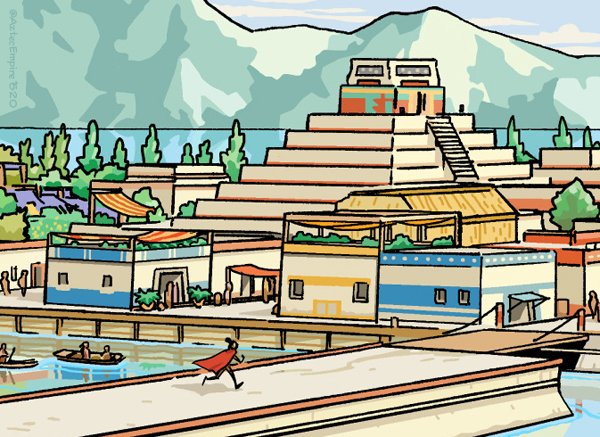
3 March 1519
Two large powers near Tenochtitlan, the Tlaxcallan confederacy and the Tarascan empire, disputed the Triple Alliance rule, but both were being slowly encircled, and their days were numbered. The Aztecs were the greatest power in Mesoamerica
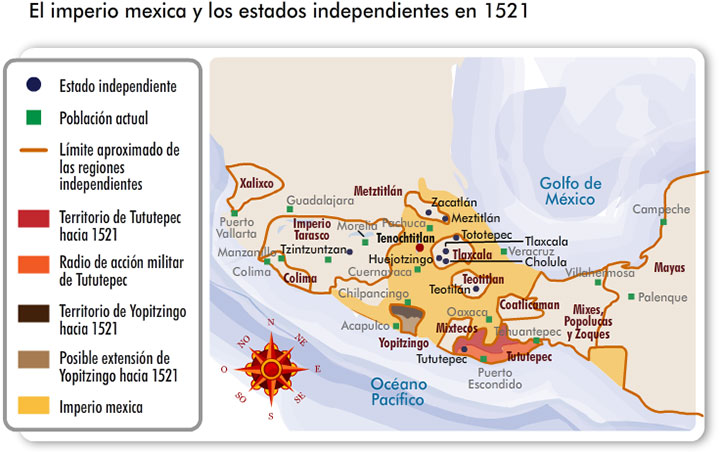
4 March 1519
Spaniard captives still missing. Cortés decides to set sails and leave Cozumel. Things start to get ready, one ship, one captain and one pilot. However, different circumstances prevent them to move forward

5 March 1519
Cortes took leave of the caziques and priests, commended them most emphatically to the image of the holy Virgin and to the cross, desiring them to pray before it, not to damage either but continually to decorate them with green boughs
He assured them that thereby they would derive great benefit. They promised to comply with all his wishes, presented him with four more fowls and two jars of honey, and then took leave of us under the most friendly embraces
6 March 1519
Cortes set sail from Cozumel and was pursuing his course with the most favorable of winds when on the very first day at ten o’clock in the morning, signals of distress were made on board one of the vessels, both by flags and the firing of guns
The ship commanded by Juan de Escalante was making straight again for the island of Cozumel. The vessel, laden with cassave-bread, was sinking fast. God forbid ! cried Cortes. Chief pilot, Alaminos, made signals for all the vessels to return to Cozumel
They unloaded the cassave-bread and found, to their great joy, that the image of the holy Virgin and cross were in the best condition, and that incense had been placed before them. It took them several days to repair the vessel
7 March 1519
When the Spaniard, who was in the power of the Indians got certain information that Cortés had again returned to the island Cozumel, he rejoiced exceedingly and thanked God with all his heart
Aguilar, the name of the captive, had unsuccessfully tried to convince Guerrero, the other captive, to join Cortés expedition. Finally only Aguilar decided to return with their comrades. Gonzalo Guerrero stayed with his new mestizo family and fighted for them
8 March 1519
Aguilar hired a canoe, with six capital rowers, for himself and the Indians who had brought him the glass beads to pay his lord for his freedom. The channel between the island and mainland, a distance of about twelve miles, was soon crossed
After they had arrived off the island and stepped on shore, some soldiers who were returning from the chase of musk swine, informed Cortes that a large canoe had just arrived from the promontory of Cotoche. Cortes despatched Andres de Tapia with a few men
As Tapia with his men approached the shore, the Indians, who had arrived with Aguilar, evinced great fear and ran back to their canoe in order to put off to sea again. Aguilar, however, told him in their language they need to have no fear
They took Aguilar also for an Indian. It was not until they had come up to them and heard the Spaniard pronounce the words God, Holy Virgin, Sevilla, in broken Spanish, and ran up to Tapia to embrace him, that they recognized this strange-looking fellow
9 March 1519
When Aguilar was introduced to Cortés, his countenance resembled that of an Indian. His complexion was naturally of a brownish cast, added to which his hair had been shorn like that of an Indian slave; he carried a paddle across his shoulder
Aguilar had one of his legs covered with an old tattered stocking; the other, which was not much better, being tied around his waist. An old ragged cloak hung over his shoulders. His prayerbook, which was very much torn, he had folded in the corner of his cloak
10 March 1519
He said, though still in broken Spanish, that his name was Jeronimo de Aguilar, and was a native of Ecija (Spain). About 8 years ago he had been shipwrecked with 15 men and 2 women, on a voyage between Darien (Panama) and the island of St. Domingo
They had undertaken that trip on account of a lawsuit between a certain Enciso and a certain Valdivia. They had 10,000 pesos on board, and papers relating to the lawsuit. The ship struck against a rock, and they had not been able to get her off again
The whole of the crew then got into the boat, in the hopes of making the island of Cuba or Jamaica, but were driven on shore by the strong currents, where the Mayan had taken them prisoners and distributed them among themselves
The most of his unfortunate companions had been sacrificed to their gods, and some had died of grief, of which also both the women pined away; being soon worn out by the hard labour of grinding, to which they had been forced by the Indians
Aguilar himself had also been doomed as a sacrifice to their idols, but made his escape during the night, and fled to the cazique with whom he had last been staying
Of all his companions, he and Gonzalo Guerrero, were only living. Aguilar had tried his best to induce him to leave, but in vain. Speaking both Maya and Spanish, Aguilar was a key value for Cortés
11 March 1519
The caziques of Cozumel showed Aguilar every possible friendship when they heard him speak in their Maya language. Aguilar advised them always to do honour to the image of the holy Virgin and cross, as they would prove a blessing to them

Aguilar was the first to send a shipment of cocoa to Europe with his recipe. The Mayas took it smoothie and mixed it with chili. He sent several bags to Antonio de Álvaro, abbot of the Monastery of Piedra in Zaragoza, where a chocolate was first made around 1534 (ver http://www.mexicolore.co.uk/maya/chocolate/cacao-use-among-the-prehispanic-maya)
Although Guerrero’s later fate is uncertain, it appears that for some years he continued to fight alongside the Maya forces against Spaniards, providing military counsel and encouraging resistance; it is speculated that he may have been killed in a later battle
12 March 1519
Cortés is eager to set sails and continue his journey to mainland, meet the Aztec civilization of which they speak since his arrival in Cozumel, and gain fame, glory, and fortune
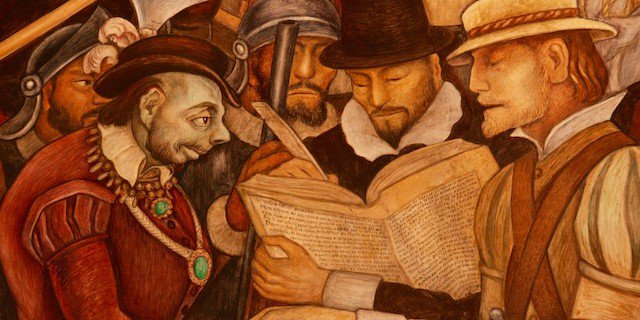
Cortes is finishing his plans, based on his knowledge of the Spanish laws (Siete Partidas), and his extraordinary skill in exploiting it to justify and legalize his own very difficult position after breaking with the governor of Cuba, and setting out unauthorized
13 March 1519
The caziques of Cozumel, upon Aguilar advice, begged of Cortes to give them letters of recommendation to other Spaniards who might run into their harbor, in order that they might not be molested. Cortés readily complied with this request
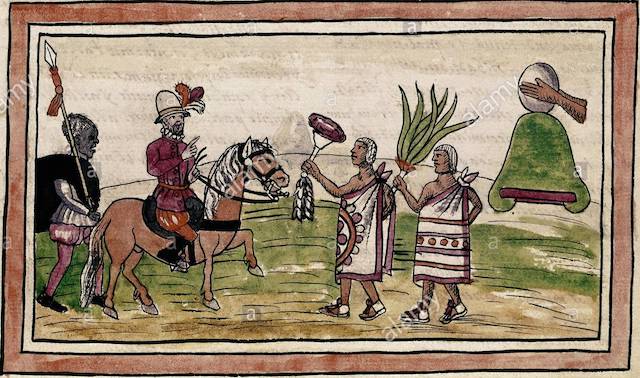
14 March 1519
After mutual signs of friendship with the caziques of Cozumel, Cortés finally weighed anchor, and set sail for the river Grijalva, formerly known as Tabasco River, well known for pilots like Alaminos. Juan de Grijalva named this river in 1518
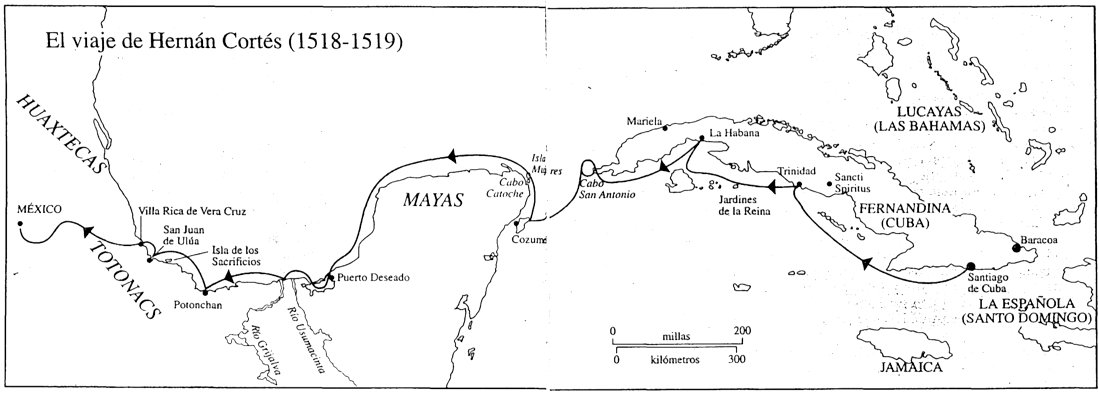
In 1518 Hernan Cortes stayed at Grijalva’s home in Trinidad, Cuba, at the start of his Mexican expedition. He recruited men there, including the five Alvarado brothers. Grijalva was killed by natives in Honduras on 21 January 1527
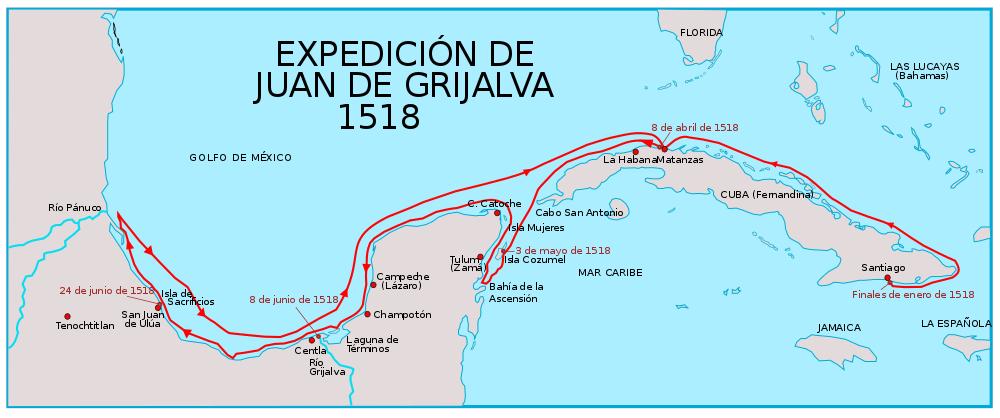
15 March 1519
Wind blowing violently last evening, towards midnight the wind abate and when daylight broke forth, all vessels again joined each other; Velazquez de Leon’s one was missing, which occasioned great anxiety, for they concluded she had been shipwrecked
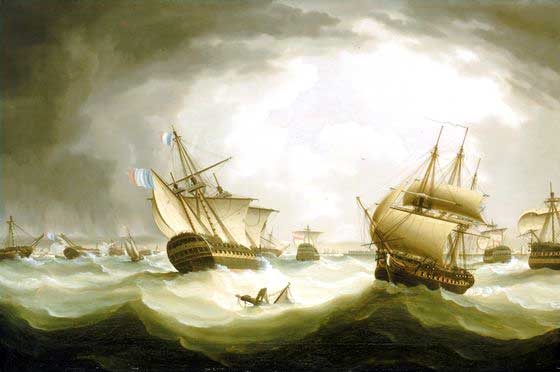
Cortes told principal pilot Alaminos not to continue without gaining some certain knowledge as to her fate: signals were made for all the vessels to drop anchor, to give the missing ship time to join the fleet
Alaminos said to Cortes: You may be sure, sir, that she has run into some harbour or inlet along this coast, where she is now wind-bound; for her pilot Manquillo has twice before visited these seas, with H. de Cordoba and Grijalva, and is acquainted with this bay
Upon this, it was resolved that the whole squadron should return to the bay which Alaminos was speaking of, in search of the vessel: to their great joy they indeed found her riding there at anchor, and they all remained there for one day
16 March 1519
Alaminos went on shore in two boats. They saw several regular corn plantations and four cues or sanctuaries on high, with numerous figures, mostly in the shape of women of considerable height; whence this promontory was called Punta de las Mujeres

17 March 1519
Cortés sent a captain Escobar with a fast-sailing vessel of small tonnage to explore the coast. Escobar arrived to Términos Bay (laguna de Términos, Campeche), where he found a lost greyhound in the previous trip of Grijalva
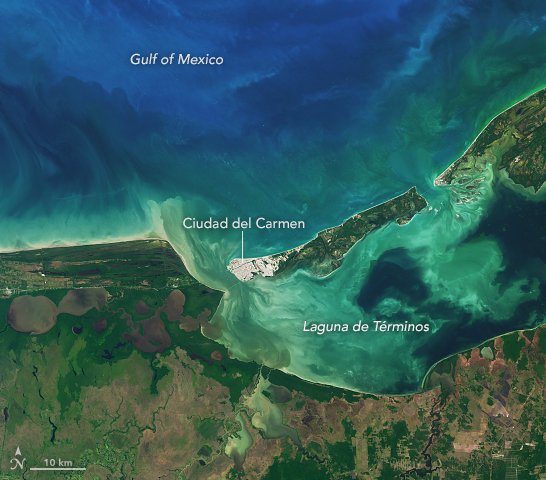
The greyhound was quite glossy and fat, and immediately knew the ship again as it entered the bay, wagging its tail, and jumping on board. Escobar intended to wait until the rest of the fleet should come up, but was driven way out to sea by a strong south wind
18 March 1519
Cortés arrived at the entrance of Términos Bay, and finally seeing Escobar, who was obliged to hold out to sea. They arrived in the waters off Potonchan, and Cortes ordered Alaminos to run into the inlet where Cordoba and Grijalva fought years ago
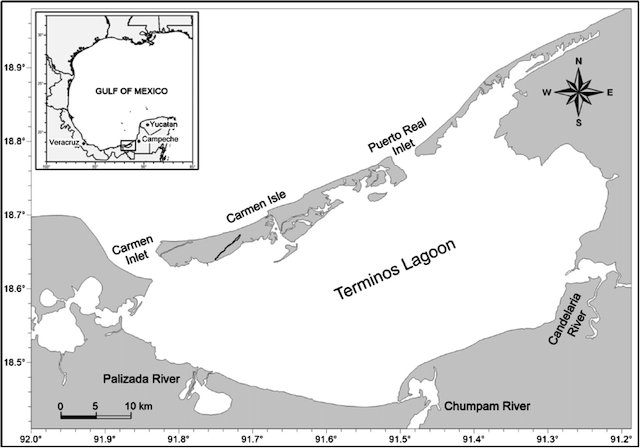
Cortes’s intention was to punish the inhabitants severely, and many soldiers who had participated in those fights begged of him to take revenge. But Alaminos said they should lose more than 3 days by running in, and if the weather became unfavorable, above eight
The wind was most favorable to reach the Tabasco river, which was their chief object. Accordingly they put out to sea, and reached the Tabasco river after three days’ sail

19 March 1519
Cortés plied Aguilar for information trying to determine the best approach to deal with the mainland Mayas, who had successfully repelled Córdoba in 1517 at Champoton, killing 20 of his force. Córdoba was also wounded and died in Cuba shortly after
20 March 1519
Hernán Cortés strode to the bow of his flagship Santa María de la Concepción, a one-hundred-ton vessel and the largest of his armada, and scanned the horizon, ready to land near Grijalva river (Tabasco river)
Meanwhile, around this date, Álvarez de Pineda in the name of Francisco de Garay, governor of Jamaica, with four ships, carrying 270 men, sailed from Jamaica to explore the Gulf coast
They aim to explore the coast between the discoveries of Ponce de León on the Florida peninsula and those made on behalf of Diego Velázquez along the southern Gulf, in hope of finding a strait to the Pacific Ocean
After clearing the Yucatán Channel, which separates Cuba and the mainland, the ships continued north until the Florida panhandle was sighted, then turned east, expecting to find the passage that was supposed to separate the “island of Florida” from the mainland
Álvarez de Pineda thus proved that Florida was not an island as it was reported in 1513. Contrary wind and strong current forced them to turn about, then sailed west and south along the coast until they found Cortés’s nascent settlement of Villa Rica, August 1519
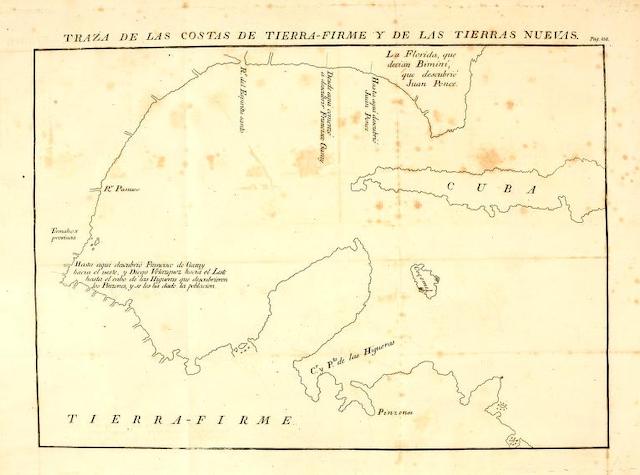
When Alonso Álvarez de Pineda explored the Gulf Coast from peninsular Florida to Veracruz in 1519, the territory was named Amichel
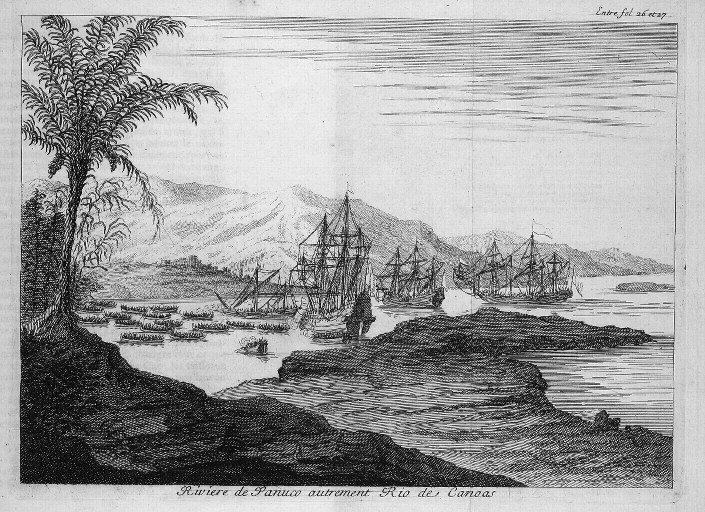
21 March 1519
The armada moved together under full sail before favorable winds towards the Tabaco river entrance (renamed by the Spaniards the Rio de Grijalva) well know by Alaminos and other expeditionaries from previous trips
22 March 1519
The fleet anchored near a sandbar at the wide and tranquil mouth of the Grijalva river, near the native settlement of Potonchan
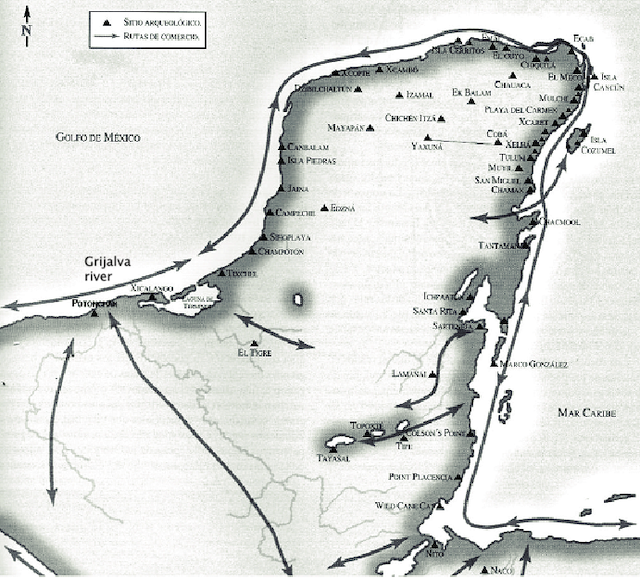
Because the water was too shallow for the bigger ships, Cortés assembled a force of two hundred soldiers and headed into the mouth of the river in brigantines and smaller vessels, the oar boats towed by the caravels
The boats slipped slowly upriver and into dank and briny mangrove swamps; the thick canopy overhead screamed and keened with shrill bird cries. The men found the place putrid-smelling
Cortés warned his pilot when he spied dugout canoes paddling toward them from upriver. Along the banks of the river, interspersed among the trees, stood hordes of Tabascan warriors armed with bows and spears, their bodies painted ochre and red, plumed in feathers
Cortés directed the bulk of his boats to a headland a safe distance away and had cannons and falconets unloaded while crossbowmen and harquebusiers stood ready. He hoped not to have to fight, but he would be ready, and his men remained at attention at all times
With Aguilar at his side, Cortés moved upriver and neared Pontonchan, a thriving commercial center, and met the first Tabascan warriors in their dugouts. Through Aguilar, he called out that he came in peace and wished only to trade goods for food and obtain water
(He had plenty of both—he was in fact nosing around for gold.) The Tabascans responded violently, shouting back at Cortés that the Spaniards should not attempt to land. The Tabascans warned that all would be killed if they advanced beyond a line of palm trees
The Spaniards named Punta de los Palmares (Point of Palm Trees).
Cortés pondered his next move as he scanned the scene, estimating the town to possess some twenty-five thousand inhabitants. The Spaniards were dramatically outnumbered
Cortés continued to negotiate, reiterating his desire for food and underscoring that he was perfectly happy to pay a fair price for whatever they might provide. As darkness fell, both sides stood at an impasse
The Tabascans said that they would report to their chiefs in town and determine whether they wished to trade. They told the Spaniards to meet them in the town square in the morning
That night, sleepless on the sandy beach and anticipating battle, Cortés sent a force of one hundred men to the outskirts of the village with orders to support him in a surprise attack from the flanks if a skirmish ensued
While the rest of the Spaniards lay swatting bugs and sweating in their heavy armor, the Tabascans evacuated the town of all women and children and hid them deep in the river delta forests
To thwart the Spaniards’ approach, Tabascan builders erected barricades and obstructions from tree trunks and branches around the town and along the river
23 March 1519
In the morning, the Tabascan representatives reiterated that they were unwilling to trade. Cortés and his men boarded their shallow-draft warships and proceeded upriver toward the town. A throng of war-painted Tabascans lined the river, chanting, shrieking, beating drums, and blowing weird siren-songs through conch shells.
Standing at the prow of his boat with Aguilar interpreting and Diego de Godoy, the king’s notary, as witness, Cortés addressed the Tabascan chiefs with Spain’s legally required forewarning or requerimiento. This ironic, devious, and self-justifying speech called on the Indians to accept Christ in lieu of their own gods and the Spanish king as their sovereign. They must acquiesce to become vassals of Spain and agree to Christian preaching and education, for which they would receive untold rewards, including peace, prosperity, and everlasting life.
The Tabascan response to this slick Spanish diplomacy was a rain of arrows, spears, and stones, and the first battle of Cortés’s conquest was joined. Though he was a leader of men, until this moment in his career Cortés had never commanded men in battle.
Cortés was forced to think quickly. The Tabascans followed their onslaught with a full charge into the river, rushing to attack the boats and pouring forth in their own dugout canoes. Some Spanish soldiers disembarked and they fought hand to hand with the Tabascans in waist-deep water, war clubs and spears meeting for the first time the fire-hardened Toledo steel of Spanish swords. With great difficulty and severely outnumbered, Cortés and his men managed to slash their way to land, but the riverbanks were so mucky that Cortés lost a boot as he clambered ashore, one foot bare. The boot was retrieved. He then commanded from the densely foliaged bank. All the while men fought, and the Tabascan warriors cried out in their language to immediately “kill or capture the Captain.”
Surrounded, the Spaniards fell into tight ranks and fought as they had been trained, in well-organized and highly regimented squads, while their enemies came at them en masse in a series of surging and retreating waves. Their organization paid off, and soon the Spaniards were tearing down and breaking through the newly constructed timber barricades and pushing the Tabascans back, the harquebusiers firing deadly balls at close range.
Just then, having heard the battle joined, Alonso de Ávila and his men, whom Cortés had ordered hidden the night before, made it through the palm woods and marshes in time to support, and now the Tabascans felt two-front pressure, as well as the deafening and utterly foreign explosions of cannons and falconets. They fled, retreating beyond the town to dense mangrove swamps and jungle, even still firing arrows and hand-thrown darts. The Spaniards’ surprise tactic had worked perfectly, and as the last of the Tabascan warriors disappeared into the shadows, Cortés and his men convened in the village square, swords still brandished.
With his royal notary Godoy at his side, Cortés strode to a great ceiba tree that stood in the central square. Raising his sword, he slashed the massive trunk symbolically three times, exclaiming before his men that he now conquered and took possession of this land “in His Majesty’s name!” (This act would have had a profound effect on the native population, for the ceiba tree was sacred, believed to be the pillar holding up the heavens themselves.)
Bernal Díaz, nursing an arrow wound in his thigh, recalled that he and a group of soldiers deeply loyal to Cortés replied with vigorous shouts of “Hear, hear,” supporting Cortés’s taking possession in the name of “His Majesty the King.” Díaz added that he would “aid against any challengers.” But a small group of soldiers, followers of Diego Velázquez who were still loyal to him, grumbled that Cortés had conveniently forgotten to mention Velázquez, under whose sponsorship they were supposedly operating. In a brazen move that did not go unnoticed by the Velázquez camp, Cortés disregarded them, for the first time publicly ignoring his patron. His actions had placed him directly under the auspices of the king, and no one else. It was his first formal move to distance himself from Velázquez.
Cortés ordered his men to rest and made an assay of his forces, determining that though a few were wounded, no Spaniard had been lost. They slept that night in the temple square, numerous sentinels posted on the perimeter, and awoke the next morning to some ominous news.
This battle is known as the Battle of Potonchan, March 23, 1519
24 March 1519
Cortés gets news that during yesterday’s battle Melchior had fled, joining the Tabascans. He was a Maya taken prisoner two years ago during an earlier expedition, having been taught some Spanish by his captors, and converted into an interpreter
Cortés feared that Melchior might inform the Tabascans of the Spaniards’ numbers and details of their weaponry, but he could do nothing but scowl in disgust at the interpreter’s treason
Cortés sent two captains, Pedro de Alvarado and Francisco de Lugo, each with about a hundred men (including specialists, musketeers and crossbowmen), to scout the nearby countryside in search of provisions
They advanced in different directions into the interior. After only three miles Lugo met great companies of archers, and others with lances and shields, drums and standards, who immediately attacked them, surrounding Lago’s men on all sides
The situation grim, Lugo dispatched a brave Cuban runner to appeal to Cortés for reinforcement. In the meantime, Lugo organized his small force in tight ranks and had his crossbowmen, falconets, and harquebusiers fire volleys at the swarming Tabascans
Hearing Lugo’s musket fire, and the enemy’s war-whoops and the beating of drums, Alvarado and his company sped to the battlefield. They arrived just in time to support Lugo. The two divisions defended themselves and repelled the onslaught as they backed into camp
They captured three prisoners, from whom Cortés got some shocking news: all the able-bodied Tabascan warriors from the vicinity would converge at the town of Cintla the next morning to make war on the intruding Spaniards
Most disconcerting of all, prisoners claimed that these warriors numbered over 25,000, about fifty times Cortés’s fighting force. They intended to surround the Spaniards and kill every last one of them
Then, in a move that would become one of his diplomatic trademarks, Cortés released a prisoner with gifts of green beads with the message to his chiefs that he wished only to trade and that he came in peace. Once they were gone, he immediately prepared for war
Cortés ordered wounded men back to the ships; crossbowmen, harquebusiers, lancers, swordsmen, and light gunners, prepared for action. He called for more artillery, dry powder, and six of the heavy cannons to be removed from the ships and transported ashore
Then, sensing that the time was right, Cortés called upon his secret weapon: the entire cavalry of sixteen Spanish horses. The animals, stiff and sore from their long journey, were lowered by pulleys and led ashore
They were the first horses to set their hooves on the Mexican mainland since before the Ice Age, when the native animals became extinct in the northern hemisphere
As the sun went down, the horses were exercised and fed. The cavalrymen prepared for battle, donning heavy steel body armor, breast and back plates, plus metal tassets for their thighs and rerebraces and vambraces for their arms
These they would sleep in, sweating through the humid night. The horses were fitted with breastplates of their own, and small bells that jingled as they went, serving to further frighten the enemy and to alert the Spaniards to the cavalry’s location
25 March 1519
The day of annunciation to the holy Virgin, at daybreak Cortés attended the Mass of Fray Bartolomé de Olmedo, the expedition’s chaplain, then he led his force of five hundred men out of the village and onto the plain of Centla
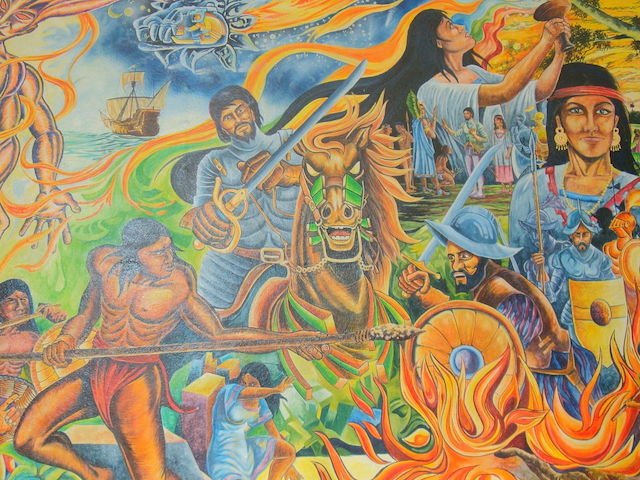
Diego de Ordás was the captain of the infantry, artillery Mesa, and Cortés himself was commanding the cavalry of 14 horsemen. Some ten thousand Tabascan warriors poured into the open maize fields, and other ten thousand were behind in support
Some warriors were decorated in ornate feather crests, pounding drums and blowing trumpets to instill fear as they ran. Their screaming faces were streaked with white and black paints signifying rank, and they carried long bows and arrows, shields and spears
The Spanish infantry, foot soldiers and musketeers and crossbowmen, took the initial onslaught, and some seventy Spaniards were badly wounded in close hand-to-hand combat. One named Saldaña was struck by an arrow in the ear and instantly dropt down dead
Cortés and the cavalry had been separated from the infantry by swamps and marshes and deep irrigation ditches that the horses could not cross, and so they were slow to arrive in support of the infantry
The infantry battled wave after wave of brave warriors using skillful sword work to repel continuous and numerically superior assaults. They fired their matchlocks, falconets and cannons. As the smoke and dust cleared Cortés arrived from the rear with his cavalry
Cortés and his cavalry charged the field, the riders wielding spears in the first mounted combat in the New World. Horse and rider galloped into the fray at great speed, charging the crowd and impaling the warriors from elevated positions
Cortés and his men speared at will, then rode and wheeled and came again, skewering and trampling the confused Tabascans. Then they would retreat to the periphery, while cannon and gunfire boomed through the valley
The Indian warriors, having never before witnessed either horses or firearms, looked on in dismay as their compatriots were easily run down. They fought bravely but were no match for the killing efficiency of firearms or horses and expert riders
Tabascans fled in terror. Within a few hours smoke hung low in the Centla Valley, and more than eight hundred warriors lay dead in the fields. Cortés’ first major military engagement on mainland Mexico had been a rout
Cortés and his cavalrymen dismounted, unsaddled, and tethered their horses, treating some that were wounded. He ordered rest and medical attention for his wounded men, nearly a fifth of his fighting force, though many of the wounds were minor
That night more than a hundred additional Spaniards fell ill with fevers, cramps, and general malaise, likely from foul water drunk from the streams, coupled with the oppressive heat and humidity
Miraculously, only two of Cortés’s men died on the battle of Centla, one slashed through the throat, the other succumbing to an arrow in his ear. It was March 25, 1519, and the conquest of the Americas had begun in earnest
26 March 1519
Willing to start peace talks, Cortés sent 5 prisoners to communicate to their caziques telling them how Spaniards longed to become their friends. First, Tabascans sent some slaves with fowls, baked fish and corn-bread. Cortés asked for their lords
Cortés treated these peculiar emissaries very kindly, presenting them with blue beads in token of peace, and in order to gain their good wishes. Aguilar told them that If their lords were desirous of making peace, persons of rank should be sent, not slaves
27 March 1519
Tabascans sent above thirty of their principals, well dressed, bringing with them, fowls, fruits, and corn-bread, and begged permission of Cortes to burn and bury the bodies of their fallen countrymen
This being granted, they brought along with them a great number of people
to burn the bodies, and bury them according to their custom. Cortes himself went to watch their proceedings, when they assured him they had lost above 800 killed, no counting the wounded
They added that at present they did not dare to enter into any treaty, as the following day all the chiefs and principal personages of the district would assemble to take Cortés’s offers of peace into consideration
28 March 1519
Cortés noticed that the natives seemed terrified of the horses and cannons. Realizing that these men understood neither the horses nor the fire-bursting cannons and guns, he prepared a show
Cortés: “It appears to me, gentlemen, that the Indians stand in great awe of our horses, and imagine that these and our guns alone fight the battle. A thought has just struck me which will further confirm them in this notion…
… You must bring here the mare of Juan Sedeno which foaled on board a short time ago, and fasten her here where I am now standing. Then bring also the stallion of the musician Ortiz, which is a very fiery animal, and will quickly scent the mare…
… As soon as you find this to be the case, lead both the horses to separate places, that the caziques may neither see the horses, nor hear them neigh, until I shall be in conversation with them.”
A little after midday, forty caziques arrived in great state and richly clothed, bringing food and offerings, including various turquoise objects and, more important, intricate masks, sculptures, and diadems fashioned in gold
They saluted Cortes, begged forgiveness for what had happened, and promised to be friendly for the future. Cortés said he was vassal of the mighty king and lord the emperor Carlos, who had sent him to favour and assist those who should submit to his imperial sway
If not, the cannons would be fired off. Cortes, at this moment, ordered that a cannon be fired at dangerously close range. The thunderous report reverberated, and the hiss of the ball whistled past the Indians’ heads and exploded foliage a great distance away
The caziques who had never seen this before, appeared dismayed, and believed everything that Cortés had said, who, nevertheless, through Aguilar, the interpreter, wished to console them and assure them that he had given orders that they should not be harmed
At this time, the stallion was carried and tied a short distance from the place where Cortés and the caziques were celebrating the conference. The stallion caught the scent of the mare and reared, kicked and neighed, then pawed and stomped the ground
When Cortes found what effect this scene had made upon the Indians, he rose from his seat and walking to the horse took hold of the bridle, whispered something and calmed it down. Cortés said that, if they cooperated, they would not be harmed
While all this was going on, above thirty porters arrived with fowls, baked fish, and fruits. A lively discourse was now kept up between Cortes and the caziques, who in the end left him with the assurance that the following day they would return with a present
29 March 1519
A number of Maya caziques arrived with more gifts, more gold, small figurines of dogs, ducks, and lizards, and twenty young slave women, who they said could be used for various tasks, although it was easy for them to become concubines as well
Pleased, Cortés inquired about the gold. Did they have more, and if not, where might he find more? Where were the mines? The Tabascans assured Cortés that they had no more gold, but they pointed to the northwest and said, “Culua, Mexico, Mexico.”
Before accepting the women, Cortés ordered that they be baptized the next morning to comply with the Castilian law that allowed to maintain relations of concubinage only between Christian and single people
Among these slaves one was a very fine woman, Malinalli, who became key for Cortés and the conquest of Tenochtitlan. She was born around 1500, possibly near Coatzacoalcos, former Olmec capital located at the southeast of the Aztec Empire, in what is now Veracruz
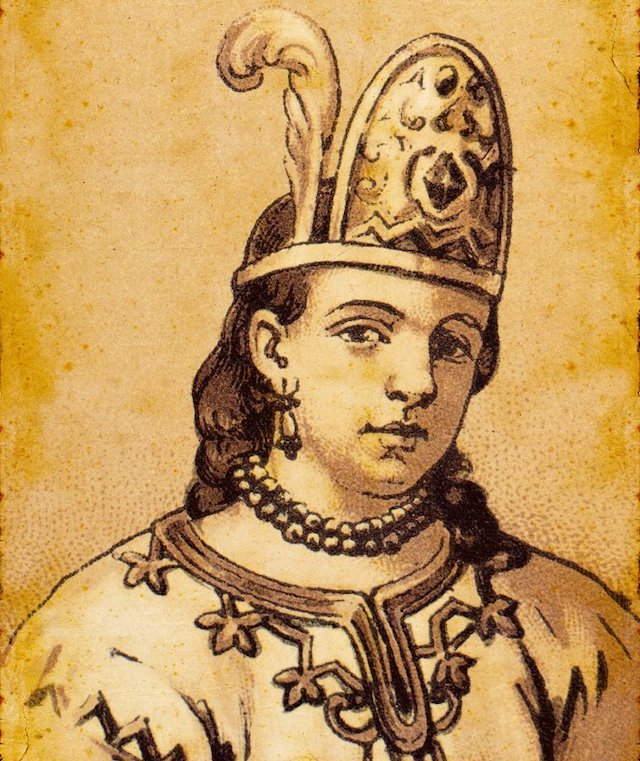
She belonged to a principal family: his father was the ruler of the city of Painala. But after her father died and her mother remarried a local man, the couple decided to get rid of the little Malinalli to secure their own heir
Taking advantage of the fact that a girl of the same age had died in the village, they made her look like her daughter and, sheltered in the darkness of the night, they gave Malinalli to some merchants
They sold her as a slave in the market of Xicalanco to other Maya merchants, who in turn ended up selling it to the lord of Potonchán, named Tabscoob. It was he who would finally deliver it to Cortés. Tabscoob also had led the Chontal Maya in the Battle of Centla
Malinalli Tenépatl spoke Nahuatl, that was a lingua franca for trade and rule during the apogee of the Aztec empire. With the lord of Potonchán, she learned to speak Mayan too. Then, she could converse with the Spaniards through Aguilar, who spoke Mayan
30 March 1519
A cross and altar were erected, and the figure of the holy Virgin being placed thereon. Father Bartolome de Olmedo read mass and, with the assistance of Aguilar, said to the twenty slave women:
“You all should abandon your belief in idols, and no longer bring them sacrifices, for they were not gods but evil spirits; you have up to this moment lived in gross error, and should now adore Jesus Christ”
After this address, the women were baptized, and Malinalli was named Marina. Being a lady of distinction, she was known as Doña Marina. Natives called her Malintzin, with -tzin as an honorific suffix. From here, in Spanish she was also know as Malinche
These were the first who were baptized in New Spain, and were distributed among Cortes’s chief officers. Doña Marina, who was the prettiest, the most active and lively of the group, was given to Puertocarrero, a stout cavalier and cousin to the earl of Medellin
Later, in July 1519, Cortés sent Puertocarrero to Spain, took Marina unto himself, and years later had a son by her: Martín Cortés, who was the firstborn male of Cortés. Born in 1523-4, he was recognized by his father and legitimized by Pope Clemente VII in 1528
Martín Cortés, the mestizo, was soon separated from his mother and given to a cousin of his father, Juan de Altamirano. Martín traveled with his father to Spain in 1529 and was pageboy of Felipe II of Spain (born in 1527) when this one was still prince
As for Malinalli, she died early, around 1530, after acting decisively as an interpreter, adviser, lover and intermediary of Cortés. Its reputation has changed over the years according to the perspectives of the time, especially after the Mexican Revolution
Cortés remained in this place until around Palm Sunday of 1519, April 17, some three weeks in total
31 March 1519
Cortes spent five days in this place, partly to heal the wounds of his men, partly for the sake of those who suffered pain in the groin, but who soon recovered. Cortés used these days in useful conversations with the caziques
He talked to them about the emperor, of his numerous lordly vassals, and the advantage they would gain by having subjected themselves to him; as, for the future, in all their difficulties they would only have to apply to him, and he would come to their assistance
The caziques thanked Cortés for this offer. They solemnly declared themselves to be vassals of the great emperor Carlos, and these were the first among the inhabitants of New Spain who subjected themselves to his majesty
Cortés remained in this place until around Palm Sunday of 1519, April 17, some three weeks in total
1 April 1519
The first Spanish city in Mexican territory was in all solemnity named Santa Maria de la Victoria. It was located in what is now the state of Tabasco, in Mexico. Now disappeared (see map of 1549)
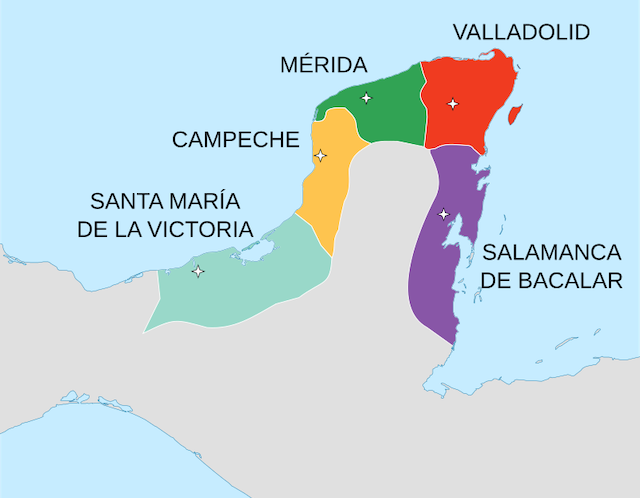
It was in the place that occupied the Maya city of Potonchán, capital of Tabscoob, on the left bank of the river Grijalva (in front of the present port of Frontera) a few leagues from the mouth to the sea. It is believed that the city of Frontera is the same town
Once capital of Tabasco, it did not have a great development due to the inhospitable of this territory covered with jungles, water and large marshes. in 1528 Francisco de Montejo started the conquest of Yucatan from there (conquest finished in 1542)
In 1641, viceroy Diego López Pacheco moved administration from Santa María de la Victoria to San Juan Bautista (today Villahermosa) and the villa was definitively abandoned
2 April 1519
The caziques, being questioned as to where they got their gold and the trinkets, answered from the country towards the setting of the sun, and pronounced the words Culua and Mexico. At that time Cortés did not comprehend the meaning of these words
They told Cortes, partly by signs, that Culua lay at a great distance, at the same time continually mentioning the word Mexico, Mexico. Cortés was then still ignorant what they wished to convey to him
3 April 1519
The caziques explained to Cortés that the war was at the instigation of their brother, the cazique of Champoton, who had previously accused them of cowardice for not having attacked Grijalva expedition last year
The same advice was also given them by Melchior, the interpreter who had run away in the battle, telling them not to leave invaders any peace day or night, as they were but few in number. Cortés desired that he should be delivered up to him
But they declared they did not know what had become of him, as on the unfortunate termination of the battle he had immediately fled. This however was an untruth, as he had paid for his advice: as shortly after the battle he was seized and sacrificed to their gods
4 April 1519
In Tenochtitlan, the capital of the Aztecs, rumours of the arrival of a powerful group of people had been confirmed by emissaries. When Moctezuma heard of Cortés’s arrival, he refused to meet with the Spaniards, instead sending gifts,
offering the tribute that frequently resolved disputes in Mesoamerican society. The Aztecs’ “superstitious” belief that Cortés was a god is a myth: they knew that other conquerors had been killed the year before, some offered to their gods as sacrificial victims
5 April 1519
When the Spaniards arrived, women were given to them as peace offerings along with food and supplies. The women had the agency to adapt to their new conditions, and some started to learn Spanish and to teach the Spaniards their own language
Malintzin had to adjust to the Spanish form of slavery after being enslaved with the Maya for several years. She had had to adjust to Maya slavery after living her youngest years as a free Nahua (Mexica is the Nahua tribe which predominated in the Aztec empire)
Her adaptation to the Spanish world was probably made easier because she could communicate with other slaves and Aguilar, who was already in Cortes’s expedition when Malintzin arrived. She showed her agency by being able to adapt to many difficult situations
During her time as a slave, Malintzin befriended Jerónimo de Aguilar (who spent eight years as a slave of the Mayas). Her ability to speak Spanish and her friendship with Aguilar quickly earned her their trust and a special place in the expedition
6 April 1519
Cortés is considering the founding of a town as soon as he finds a convenient place for it. The purpose is not to start building a village but to create a new basis of authority to replace the one given to Cortés by his patron, the governor of Cuba
It would also permit this group of conquistadors to turn themselves into a cabildo (town council) and thereby acquire standing sufficient to make certain kinds of resolutions, laws, and other legally valid decisions, under the direct authority of the crown
Spaniards placed great emphasis on city-dwelling, equating it with civilization, social status, and security. Cortés also needed the direct approval of the crown in order to claim governorship of whatever lands he was able to conquer
7 April 1519
Meanwhile in Tenochtitlan, Moctezuma gave orders to Pinotl of Cuetlaxtlan and to other officials: “Give out this order: a watch is to be kept along all the shores at Nauhtla, Tuztlan, Mictlancuauhtla, wherever the strangers appear.”
Then called his chiefs together; Tlilpotonque, the serpent woman, Cuappiatzin, the chief of the house of arrows, Quetzalaztatzin, the keeper of the chalk, and Hecateupatiltzin, the chief of the refugees from the south
Cortés arrived on the eastern shores of the Aztec empire in the year 1-Acatl. After the conquest, the xiuhpohualli (solar calendar) became tied to the Julian calendar, introducing a leap year to the Aztec calendar every four years. See: https://www.azteccalendar.com
8 April 1519
Charles I of Spain, after the death of his paternal grandfather, Maximilian (12 January 1519) inherited the Habsburg Monarchy. He was also the natural candidate to succeed his grandfather as Holy Roman Emperor. A critical election was underway
The resulting “election campaign” was unprecedented: Charles I of Spain, ‘German by blood and stock’, defeated the candidacies of Francis I of France, Henry VIII of England, and Frederick III, Elector of Saxony. The electors gave Charles the crown on 28 June 1519
Charles was the heir of three of Europe’s leading dynasties: Trastámara of Spain, Habsburg of Austria, and Valois of Burgundy. The personal union under Charles V was the closest Europe has come to a universal monarchy since Charlemagne in the 9th century
Because of widespread fears that his vast inheritance would lead to the realisation of a universal monarchy and that he was trying to create a European hegemony, Charles I of Spain was the object of hostility and prolonged conflicts and wars from many enemies
9 April 1519
Two messengers arrived to Tenochtitlan and went to the House of the Serpent. When Moctezuma appeared, two captives were then sacrificed before his eyes: their breasts were torn open, and the messengers were sprinkled with their blood
When the sacrifice was finished, the messengers reported to the king. They told him what they had seen, and what food the strangers ate. Moctezuma was astonished and terrified to learn how the cannon roared, the smoke that comes out, and the pestilent odor
The messengers also said: “Their trappings and arms are all made of iron. They dress in iron and wear iron casques on their heads. Their swords are iron. Their deer carry them on their backs wherever they wish to go. Their beards are long and yellow.”
When Moctezuma heard the messengers’ report, with its description of strange animals and other marvels, his thoughts were even more disturbed. Days of intense fear and uncertainties were coming to the Aztec empire
10 April 1519
It is Sunday, the Spaniards attend the mass read by Fray Bartolomé de Olmedo. The image of the holy Virgin presided over the mass in the courtyard, where they had erected an altar and a cross
11 April 1519
The invaders remain in occupation of Potonchán and the village renamed Santa María de la Victoria. High above, in the Valley of Mexico, Moctezuma had difficult decisions to make
12 April 1519
Cortés is waiting for fair winds to set a course to the northwest along the coast, laying tight to shore, heading toward the port that Grijalva, on his previous expedition, had named San Juan de Ulúa (first called the Isle of Sacrifices)
13 April 1519
The ruler of the Aztec empire, Moctezuma II, had succeeded Ahuitzotl in 1502. His power became absolute in the empire, and he soon began subjugating the unconquered peoples of the terrain
However, the Aztec rule over central and southern part of Mexico was not secure, since the domains of the Valley of Puebla and Tlaxcala challenged their authority. In addition, their establishment of rule had only been recently acquired, dating from 1504 to 1516
14 April 1519
From 1503-20, the Aztec Empire suffered a period of tumultuous upheavals; colonized territories struggled for independence and in most cases were brutally subdued. The towns of Quetzaltepec and Tototepec serve as an example of Moctezuma’s brutality
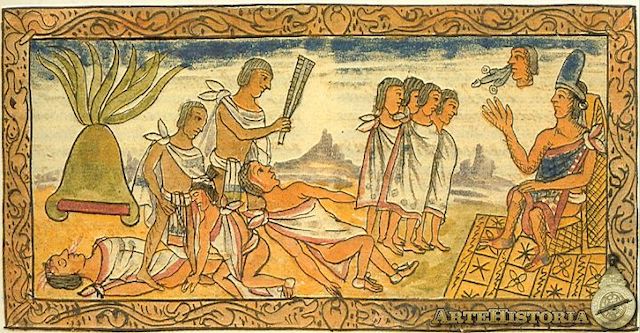
Moctezuma’s army of 400,000 men razed the two towns. The king formed several brigades of warriors, allowing all of his men time to eat and rest. While one brigade stormed Quetzaltepec and Tototepec, the other brigades rested
By the end of the first day of fighting, the cities had been breached. Other Aztec troops approached the Quetzalli River, quickly crossed it in canoes, and took control of the area. Moctezuma’s tactics assured the Aztec a quick and bloody victory
15 April 1519
Context in Spain circa 1519: Nebrija’s rhetoric of the period is an acknowledgement of the role that Spain’s humanist reform might perform in consolidating and complementing the military might of a kingdom destined for further territorial expansion
Nebrija (1444-1522) would celebrate his reforms as a holy war or crusade against intellectual backwardness (‘barbarism’). An emblematic example of this imagery is found in the introduction to the Vocabulario de Romance en Latín from 1516
Here Nebrija would describe his early attempts at Latinate reform in Castile as a crusade against ignorant pagans so as to draw an analogy between his task and that of the apostles Christianizing the ancient pagan world
The reform of Nebrija was followed by the Protestant Reformation, a movement that posed a religious and political challenge to the Roman Catholic church and papal authority in particular: the Ninety-five Theses by Martin Luther in 1517 and the 1521 Edict of Worms
This is an example of what we mean by saying with Elliott ‘we need to set Cortes very firmly into the context of the society from which he sprang, late medieval and early Renaissance Spain, for he at once mirrors the ideals and aspirations of that society’
16 April 1519
As the day following was Palm Sunday, Cortés desired the caziques to come early in the morning to pray before the holy mother of God. He also sent for six Indian carpenters to assist in making a cross on a high ceiba tree near the village of Centla
This cross was made in a manner so as to be very durable, for the bark of the tree, which always grows to again, was so cut as to form that figure. Lastly, Cortes desired the Indians to bring out all their canoes in order to assist us in reembarking
For Cortés was desirous of setting sail on that holy day, as, according to pilot Alaminos, their present station was not secure from the north winds.
17 April 1519
Palm Sunday. Early in the morning the caziques and the principal personages, all with their wives and children, made their appearance in the courtyard, where Cortés had erected the altar and cross, and collected the palm branches for the procession
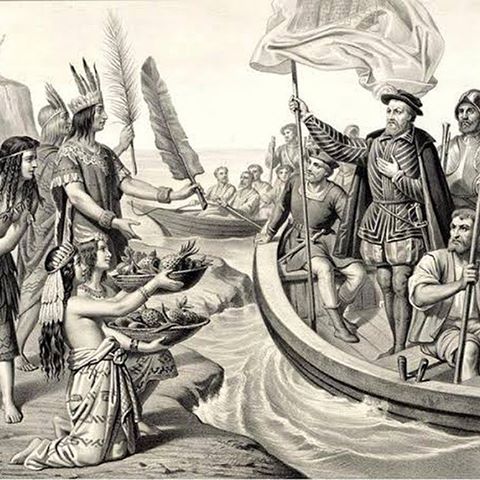
Father Bartolome de Olmedo, belonging to the order of the charitable brethren, and Juan Diaz, were dressed in their full canonicals, and read mass. We prayed before the cross and kissed it, the caziques and Indians all the while looking on
The principal Indians brought ten fowls, baked fish, and all kinds of greens. Cortés recommended them to take care of the image of the holy Virgin and the cross, and to hold the chapel in due reverence, in order that salvation and blessings might come upon them
All expeditioners embarked in the evening. Cortés thanked the Tabascan chiefs, loaded the gifts of food, gold, and the slave girls, and readied to set sail for the north. They would search for and find this place called “Mexico.”
18 April 1519
On Easter Monday morning Cortés set sail with a good wind. They always kept close to the shore, and steered in the direction of San Juan de Ulúa. They coasted along for three days, the weather being most favorable
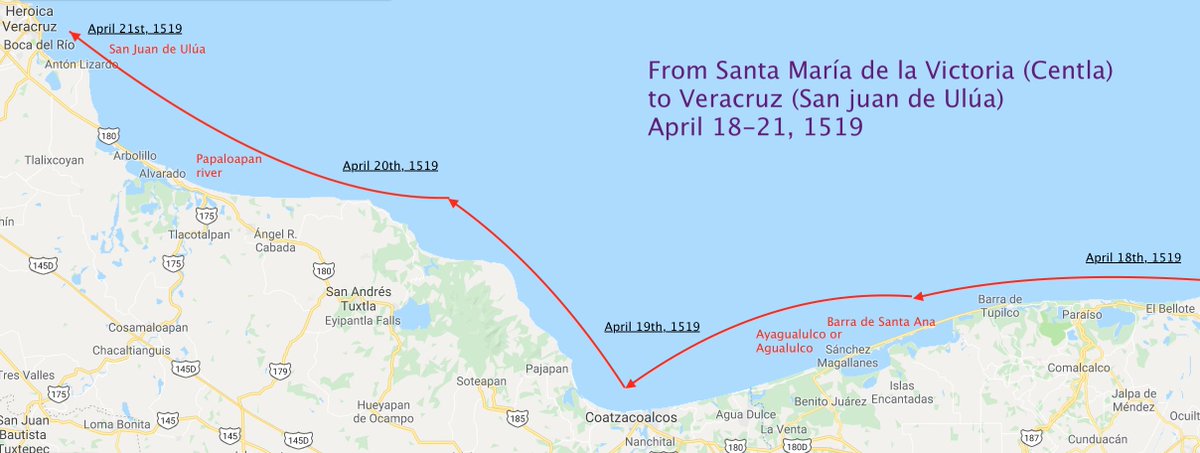
Bernal Diaz: “We who had been here with Grijalva, and were well acquainted with these parts, pointed out to Cortés La Rambla, which the Indians call Ayagualulco; the coast of Tonalá or San Antón, the great river Guazacualco (Coatzacoalcos), the snow mountains”
“And those of San Martin, the split rock forming two points, which stretch out into the sea, and somewhat resemble the figure of a chair. We then showed him the river Alvarado (now Papaloapan river), further on the river Banderas, where we made the 16000 pesos”
“The Isla Blanca and Isla Verde, also the Isla de Sacrificios, where, under Grijalva, we found the idols with the Indians who had been recently sacrificed” See geographical references in https://bit.ly/2VSVxkk
19 April 1519
Under fair winds, the entire fleet set a course to the northwest along the coast, laying tight to shore, watching the coast of Tonalá and the great Coatzacoalcos river. Cortés, on the Santa María de la Concepción, continued to scan the shoreline
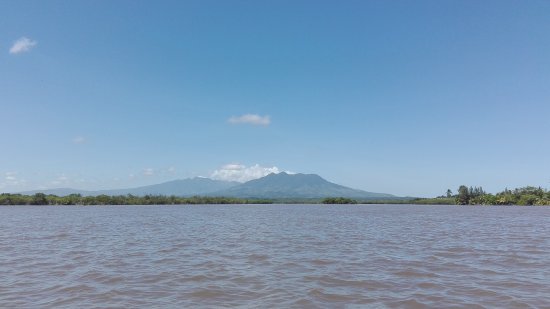
20 April 1519
Cortés’ fleet progressed westward arriving to Rio de Alvarado, now Papaloapan river, on the border between the states of Veracruz and Oaxaca. Its name comes from the Nahuatl “papaloapan” meaning “river of the butterflies”
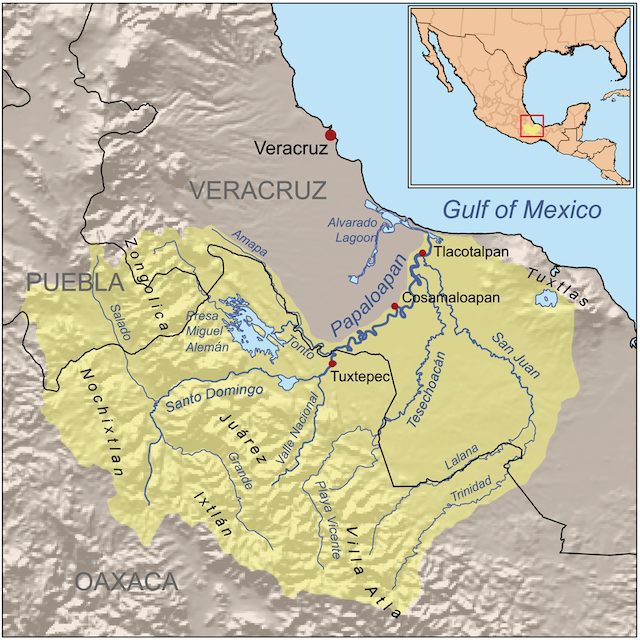

21 April 1519
Holy Thursday. The fleet drops anchor in the harbor of San Juan de Ulúa, all anchored close by, protected from strong northerly winds. Cortés ordered Spanish pennants and royal flags raised on the Santa María de la Concepción
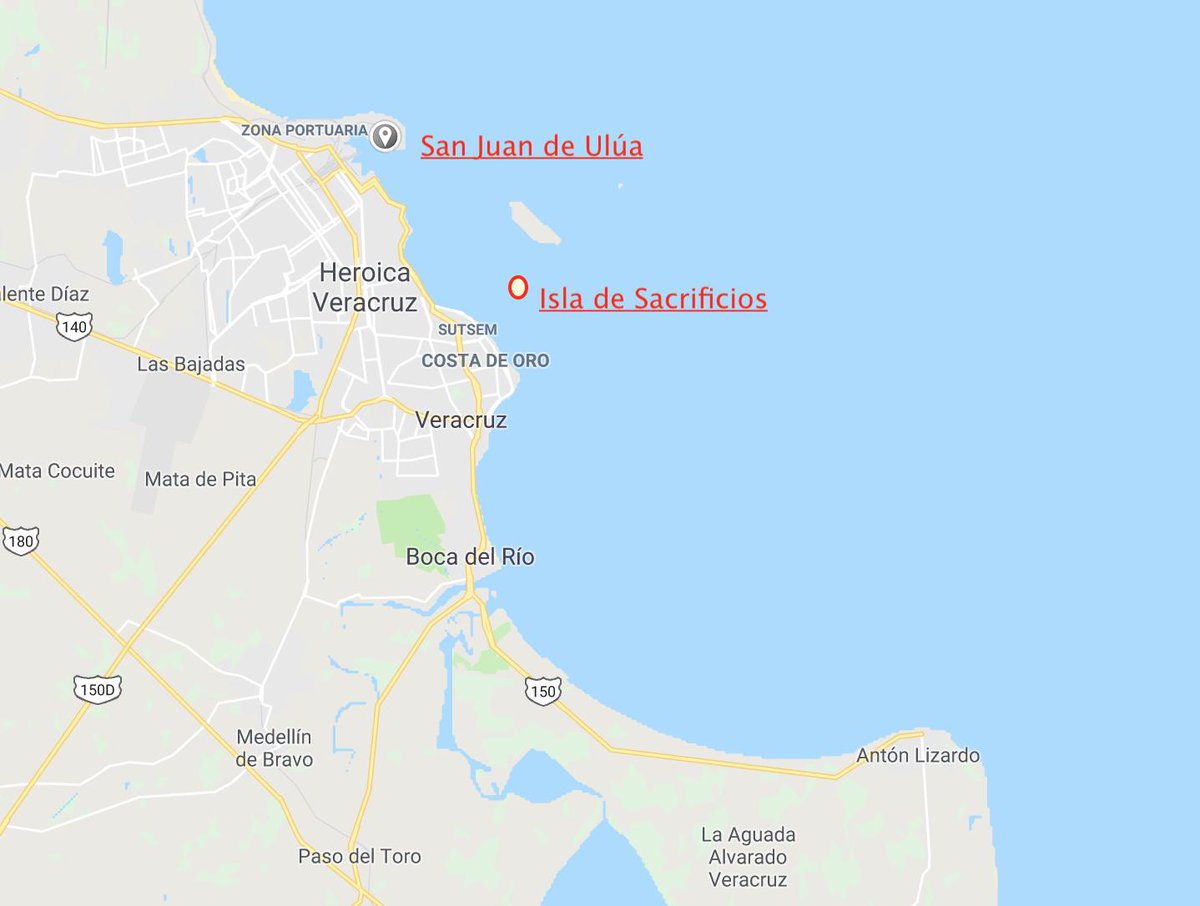
Shortly after, a boat bearing two subordinates of the regional Aztec administrator Teutliltzin (also rendered as Teudile or Teudilli) contacts the visitors inquiring as to their intentions
Bernal Díaz: “Alaminos brought our ships to anchor in a place where they were sheltered from the north wind. We had scarcely lain here half an hour when we saw two large canoes, which are called here pirogues…”
“filled with a number of Indians, making straight for Cortés’ s vessel which” from the large flag hanging from the mast-head, they recognized as our
commander’s ship. They climbed on board without any ceremony, and inquired for the Tlatoan, which means master.”
“Doña Marina understood their question, and pointed to Cortés; they, therefore, turned to him, paying him great reverence after the Indian fashion, and bid him welcome. Their master, they said, who was a servant of the great Moctezuma, had sent them”
“…in order to ascertain who we were and what we came to seek in his country. We had only to inform them of what we wanted for our ships, and they would see that it was provided. Cortes thanked them for their kindness, through Aguilar and Doña Marina”
“…presented them with some blue glass beads, and ordered some meat and drink to be placed before them. After they had taken some refreshment, he told them we were merely come here to make their acquaintance, and open a trade with them”
“…we had not the remotest intention of doing them any injury, nor need they apprehend anything from our arrival. The ambassadors now returned, well contented, to their homes”
22 April 1519
Good Friday. Cortés ferries his army ashore, complete with horses and cannon, and has his Cuban laborers swiftly fell trees and erect a fortified camp opposite San Juan de Ulúa. The Spaniards are given a friendly reception by the local Totonacs
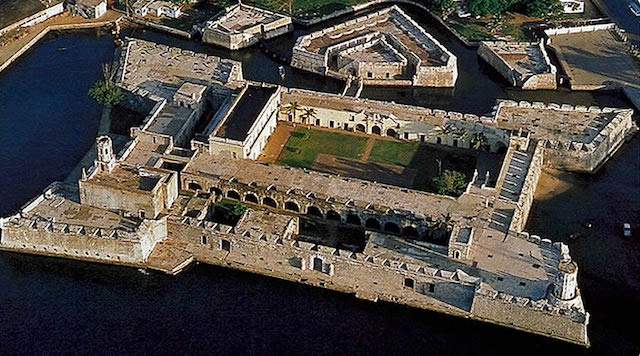
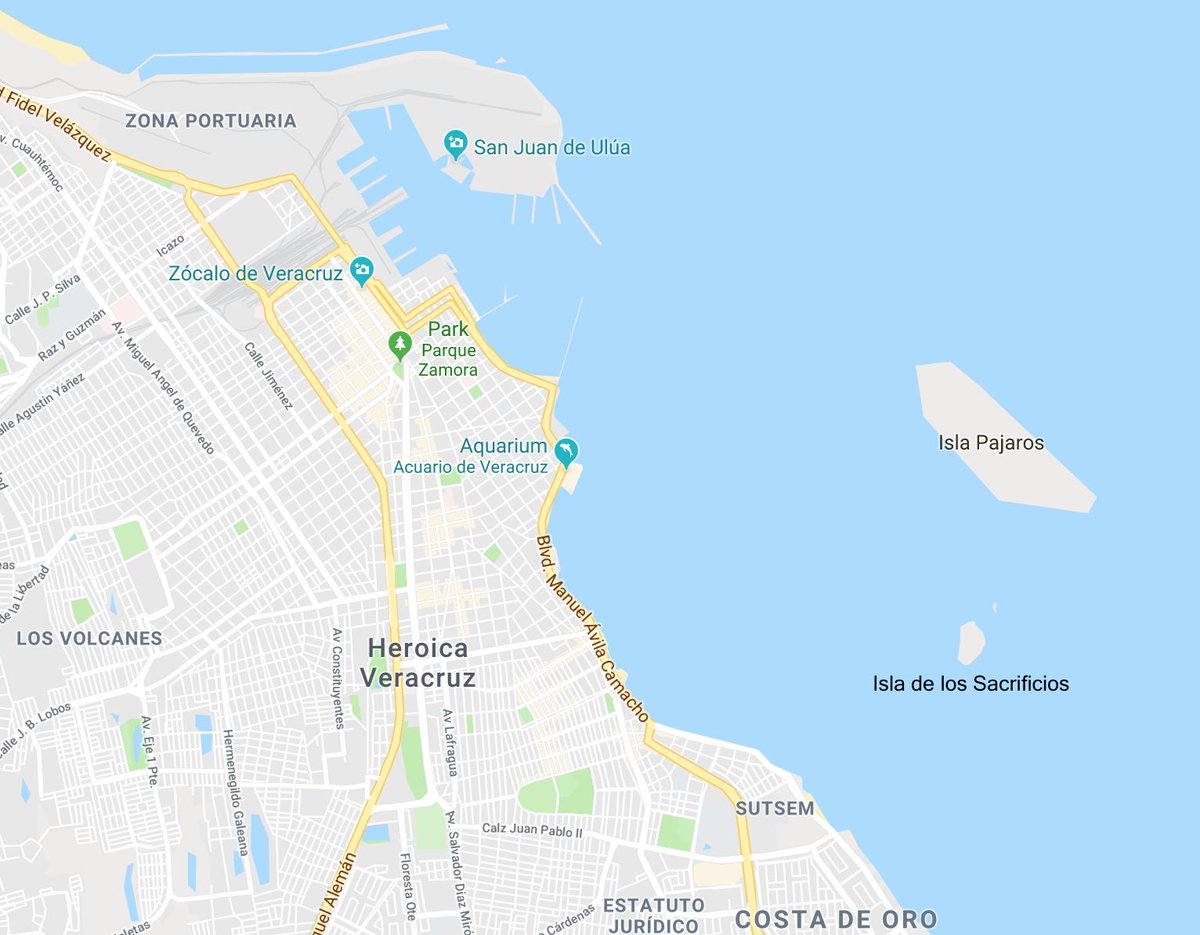
Mesa, the captain of artillery, placed the cannon on a very advantageous spot, and they erected an altar where mass was immediately performed. For Cortés and the other chief officers huts were constructed of green boughs
23 April 1519
Holy Saturday. In the morning, emissaries began to arrive at the Spaniards’ makeshift camp. The first group claimed to have been sent by their leader Cuitlalpitoc (incidentally, the same man who had been sent to parlay with Grijalva)

Through Aguilar and Malintzin Cortés first heard utterance of the name Moctezuma. Aguilar spoke Mayan and Spanish. Malintzin spoke Mayan and Nahuatl. So, they translated Nahuatl <-> Mayan <-> Spanish. Through Aguilar Malintzin learnt Spanish with remarkable speed

This man Moctezuma was said to be the powerful ruler of the Mexica, a feared Triple Alliance of the city-states Tenochtitlán, Texcoco, and Tacuba, who inhabited the Valley of Mexico. Cortés listened carefully, receiving Cuitlalpitoc with kindness and hospitality
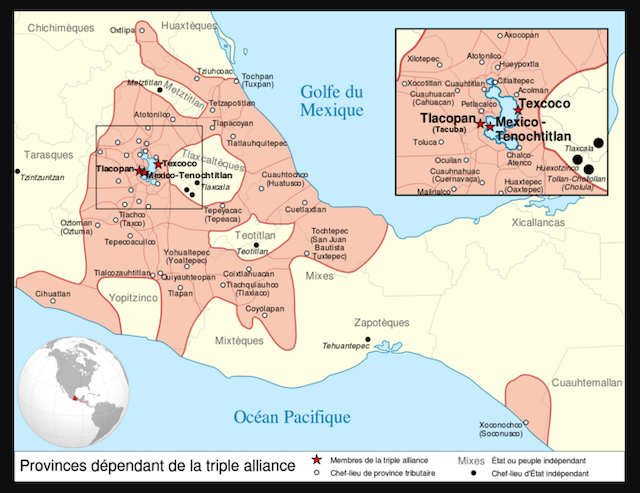
More ambassadors arrived bringing elaborate gifts, including a crafted feather garment, a war shield inlaid with opalescent mother-of-pearl, and a lot of food. They said that Cortés should expect a visit soon from a very important governor of Moctezuma, then left
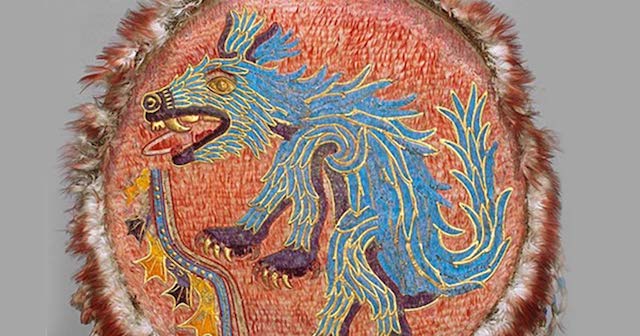
24 April 1519
Easter Sunday. The ambassador Tendile (Teutliltzin) arrived as promised with a few thousand attendants in tow, all dressed in feathered finery and elaborately embroidered cloaks, nobles carrying gifts and provisions
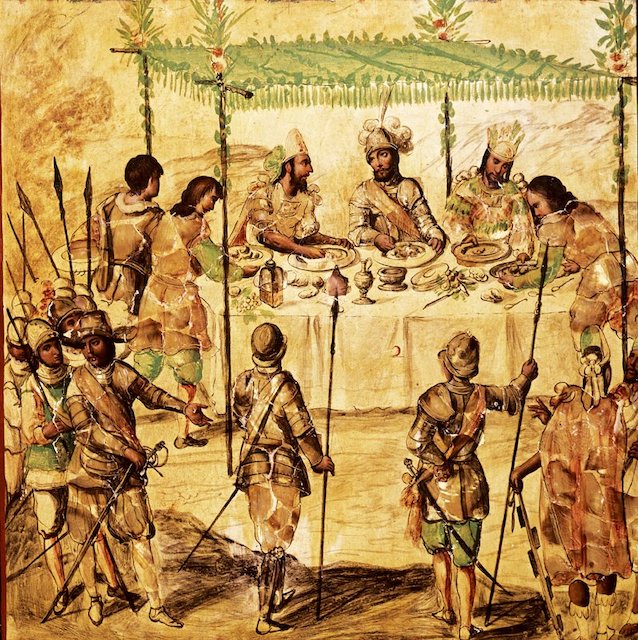
Fray Olmedo read mass, which Tendile and his nobles listened to with great curiosity and interest. After that, Tendile followed with a ritual of his own, as he and some other noblemen performed a “dirt eating” ceremony
In the ceremony, they dampened their fingers, touched them to the earth, then placed the dirt-smudged fingers to their lips in a show of respect. They handed Cortés sticks of burning incense and reeds dipped in their blood
Tendile then brought forth bearers carrying great chests, from which he proffered gifts from the great Moctezuma, his emperor from high above and far away in the mountains, a deeply feared and sovereign leader who ruled from the capital city, called Tenochtitlán
Cortés told Tendile that he too served a most powerful king, one who lived across the vast seas to the east, and that his own king knew well of the great Moctezuma. Cortés added he had instructions to meet personally with Moctezuma and would expect nothing less
Cortés noticed the concerned expression on Tendile’s face when he learned of this ruler from the east, for there existed a myth proclaiming that very thing: the return of the god Quetzalcoatl coming from the east
For the moment, though, Tendile simply nodded and spoke to one of his attendants, who was sketching furiously on a large canvas made from the dried and stretched flesh of the maguey plant
Cortés inquired about it, and Tendile informed him that this was “picture writing,” and that his painters were recording all the proceedings, so that they could report accurately to Moctezuma what they had observed and learned
Bernal Díaz remembered that Tendile gave his painters instructions “to make realistic full-length portraits of Cortés and all his captains and soldiers, also to draw the ships, sails, and horses, Doña Marina [Malintzin] and Aguilar, and even two greyhounds.”
Cortés then ordered an impressive, awesome display of power that quite literally put the fear of god in Tendile and his men, for indeed the weapons and the animals possessed such power and novelty that Tendile wondered if these creatures might be teules—gods
Tendile then inquired about a particular helmet worn by one of the Spaniards who had been performing military exercises on the beach. He noted that this helmet possessed a resemblance to those worn by their war gods, including Huitzilopochtli and Quetzalcoatl
Cortés responded that Tendile could certainly take the helmet under the condition that it be returned filled with grains of Aztec gold, which he might compare with that of his homeland in Spain and give as a gift to his own great monarch across the eastern oceans
Of his desire and interest in Aztec gold, Cortés added that “I and my companions suffer from a disease of the heart which can be cured only with gold.”
(Cortés could have previously learned about Huitzilopochtli, the highest deity in the Aztec pantheon, and its insatiable hunger for blood and human hearts. Then he elaborated the story of the disease of the heart and the need for gold as a cure)
Tendile departed, assuring the captain that his people would supply the visiting Spaniards with food on the beach and that he would soon return with a response from his ruler in Tenochtitlán
As a generous parting gift, Tendile had left Cortés with some two thousand servants, workers instructed to construct hundreds more huts and shelters for the Spaniards. They also offered women to make maize cakes and cook fowl and fish, which they provided daily
25 April 1519
The report of the Spaniards coming to the shores was brought to Moctezuma, who immediately sent out messengers. It was as if he thought the new arrival was their prince Quetzalcoatl

This is what Moctezuma felt in his heart: He has appeared! He has come back! He will come here, to the place of his throne and canopy, for that is what he promised when he departed! (Codex Florentino)
Moctezuma sent five messengers to greet the strangers and to bring them gifts, led by the priest in charge of the sanctuary of Yohualichan. The second was from Tepoztlan; the third, from Tizatlan; the fourth, from Huehuetlan; and the fifth, from Mictlan the Great
Moctezuma said to them: “Come forward, my Jaguar Knights, come forward. It is said that our lord has returned to this land. Go to meet him. Go to hear him. Listen well to what he tells you; listen and remember.”
26 April 1519
Moctezuma gave the messengers his final orders to meet the strangers: “Go now, without delay. Do reverence to our lord the god: Say to him: Your deputy, Moctezuma, has sent us to you. Here are the presents with which he welcomes you home to Mexico”

(Interestingly, it seems Moctezuma and the founder of Spanish Guardia Civil, the Duke of Ahumada, are related: https://bit.ly/2FIDYxP . A family history that is an example of how the Mesoamerica elites were involved with the Spaniards’ ones for almost 300 years)
****************************
Comentarios y otros tweets que reflejan mi idea:
In addition to wars, epidemics and terrible crimes, the Spaniards brought with them civilization, universities, language, religion, laws, etc. It was like the Roman Empire for Western Europe. When did the United States or the British Empire behave like this?
Cortés changed the entire Aztec world, but he also created a new one, and for this he used more intelligence than a dragon. Spain destroyed, but it also invested men and resources to build a new civilized world for almost 300 years
Many complex civilizations have been replaced throughout history. In my opinion, what is unique in Mesoamerica is the joint development, driven by Spain, and the creation of a new world following Western standards, for better or for worse
****************************
27 April 1519
Learning that the visitors wish to meet the Emperor Moctezuma II at his capital of Tenochtitlán (now Mexico City), Teutliltzin sends a request and other reports inland by messenger, while assigning 2,000 native tributaries to wait upon the Spaniards
28 April 1519
Cortés and Malintzin were developing something more than just good rapport. She had been at Cortés’s side since the moment he discovered her linguistic prowess, and she would remain there for the duration of the expedition
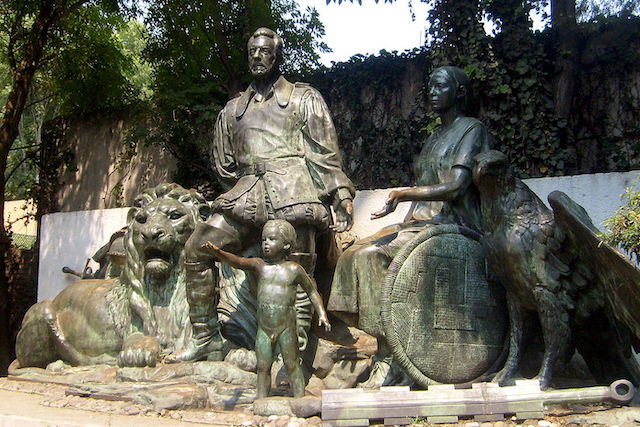
29 April 1519
The symbol of the Fleur de Lis changed the course of New World History. A surprising confluence of religious ideas recognized in both the Old and New World and symbolized by the trefoil design we know as the Fleur de lis

In both hemispheres the Fleur de lis symbol is associated with divine rulership, linked to mythological deities in the guise of a serpent, feline, and bird, associated with a Tree of Life, it’s forbidden fruit and a trinity of creator gods
In Mesoamerica, as in the Old World, the royal line of the king was considered to be of divine origin, linked to the Tree of Life
Descendants of the Mesoamerican god-king Quetzalcoatl, and thus all Mesoamerican kings or rulers, were also identified with the trefoil, or Fleur de lis symbol. Read the article by Carl de Borhegyi
30 April 1519
A trip around the world of 1500. The Universal Nautical Chart of the Spanish navigator and cartographer Juan de la Cosa (c. 1450 – 1510), the first cartography of the Americas (Image rotated to match modern map orientation) – see link
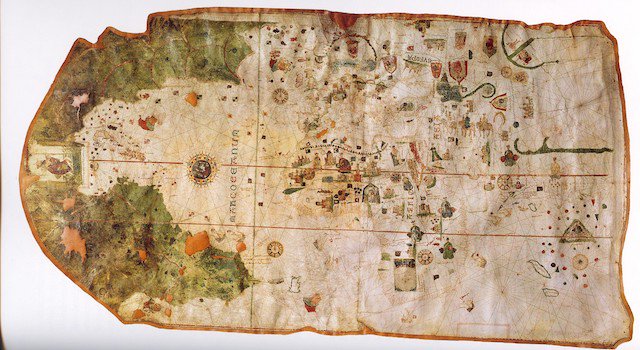
It constitutes the maximum expression of the knowledge of the world towards year 1500. Its political importance probably was worth the classification as Secret of State on the part of the Catholic Kings. See link to Spanish Naval Museum
1 May 1519
In the Crónica Mexicana, by Tezozomoc (1598), Moctezuma, believing that the men who’d embarked on the coast of the Gulf of Mexico were messengers from the god Quetzalcoatl – who, according to Mexican myth, would return to govern his people – sent…
… his own men to receive them, loaded with presents. Tezozomoc ofers a detailed list of the gifs sent for this frst interview: maize, chile, tamales and “all manner of food, very well-made tamales, sent still hot, ordinary tortillas and tamales with beans, …
.. round like thick rods, and all sorts of cooked and grilled fowl, quail, barbecued deer, rabbits, ground chile, many kinds of cooked quelites or greens, and fruits like plantains, custard apples, guavas and chayote squash” (Tezozomoc, see link)
Read Crónica Mexicana, edited by G. Díaz Migoyo, online in Spanish: see link to this book
2 May 1519
About eight days after their first encounter, Tendile returned from Tenochtitlan leading a retinue of over one hundred bearers, strung in a long line behind him, and accompanied by a person of distinction named Quintalbor, who greatly resembled Cortés
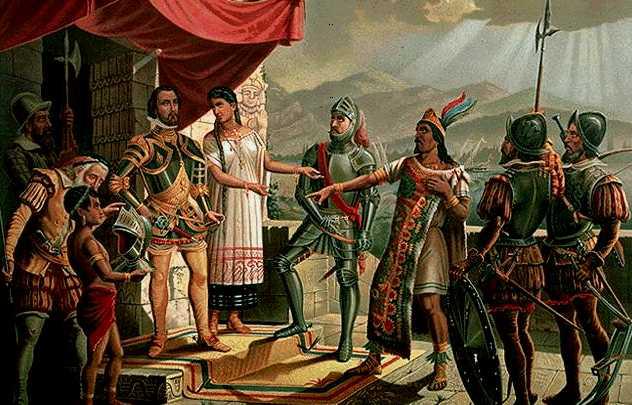
For this reason, Quintalbor had been selected by Moctezuma to accompany the deputation; for, when Tendile brought forth the picture representing Cortés, all the grandees who were present with Moctezuma, immediately observed that Cortés resembled Quintalbor
Arriving before Cortés, Tendile and Quintalbor kissed the earth and perfumed the Spaniard and the soldiers around him with smoke from incense burning in earthen braziers. Then Tendile’s attendants laid out numerous woven presentation mats called petates
Then, they spread generous gifts from Moctezuma himself: plates and sandals, all of pure gold, and a strung bow and a dozen arrows of solid gold. They set out two enormous plates of gold and silver which were according to Bernal Díaz “as large as carriage wheels”
3 May 1519
One of these impressive disks represented the sun, the heavy gold carved elaborately with depictions of plants and animals; the silver plate, slightly larger, symbolized the moon
Cortés marveled at the intricately woven and resplendently dyed cotton garments, cloaks of featherwork of inestimable beauty , created by highly skilled craftsmen. The jewelry—gold collars and necklaces and bracelets—was inlaid with shimmering precious stones
Also on the mats were laid golden deer and ducks and dogs, jaguars and monkeys and fish, golden rods and staffs. The Mexicans presented the helmet Tendile had taken, filled as requested with gold flakes and nuggets directly from the mines
Cortés stood amazed before the generous and wondrous artifacts, conscious for the first time that he was dealing with people of a highly civilized and established culture who could mine and then intricately fabricate precious metals
Tendile, seeing that Cortés was pleased, paused to let his pleasure sink in. Then he intimated Moctezuma’s wishes and his message: with great pleasure he offered these gifts to Spain’s king, and he was happy to have this direct communication
But Moctezuma would not come personally to see them, and under no circumstances could they visit him. Moctezuma’s instructions were polite but specific: the Spaniards were to take his gifts as gestures of good faith and evidence of his wealth and power— and leave
Moctezuma’s gifts had also piqued the greed and desire of the Spaniards. Seeing this imperial haul, Cortés had no intention of leaving. He remained calm in his dealings with Tendile, and decided to push him saying that his own king would be unhappy with him
He thanked Tendile profusely for the gifts but wished him to return once more to Moctezuma and express his deep desire for a meeting. He presented for Moctezuma several tokens of his great respect
These included a number of Dutch shirts woven of fine linen, a Florentine glass goblet engraved with scenes of hunting, and handfuls of glass beads. Cortés gave what he could and sent Tendile away, still hoping for a personal audience.
4 May 1519
Once Tendile left, Cortés assessed their situation on the dunes. It was untenable. The sands grew scorching hot during the day, and the area was surrounded by stagnant marshes that produced thick clouds of flies, gnats, and mosquitoes
Many of his men were racked with stomach cramps and bowel disorders, some even succumbing to tropical bilious fever. So far some thirty of his men had perished from battle wounds and diseases. What food they had was spoiling in the hot sun or in the ships’ holds
Perhaps even worse, there were grumblings of discord among his men; some suggested that they should take the gifts and return immediately to Cuba. Cortés dispatched two expeditions—one over land and one by sea—to discover a more suitable location for settlement
He sent two brigantines, one piloted by Alaminos and captained by his own loyal friend Rodrigo Álvarez, the other under the captaincy of a Velázquez supporter named Francisco de Montejo, manned by some fifty soldiers, nearly all devoted to the governor of Cuba
As it turned out, Cortés’s choice to send away the bulk of the Velázquez sympathizers appears not to have been accidental. Álvarez and Montejo were to seek a better harbor and a landing site that was not plagued by lowland marshes, swamps and the attendant swarms
Cortés assigned Juan Velázquez de León, a relative of Velázquez, to foray into the interior for three days, also in search of more favorable surroundings for settlement and fortification
5 May 1519
In the Valley of Mexico, Moctezuma had difficult decisions to make. Deeply spiritual, having been a high priest before becoming emperor, his priests suggested that the invading Spaniards be driven back to where they came from or, better yet, killed
He learned from his spies and emissaries that along his route Cortés and his men had been destroying temples and replacing native idols with their own. Moreover these Spaniards were strangely served by beasts and they carried fire and thunder in their hands
Tradition held, and Moctezuma fully believed, that the Aztec capital was the sacred center of the universe, and spiritual epicenter of his vast empire, but he feared also that the arrival of this Cortés was predestined
The myth of Quetzalcoatl told that the bearded royal ancestor would one day arrive to “shake the foundation of heaven” and conquer Tenochtitlán. Moctezuma listened to his priests and mused
6 May 1519
Cuitlalpitoc, who had remained to furnish Cortés and his men with provisions, soon ceased to do so altogether, which, of course, created a great scarcity of food: their cassave-bread had likewise become quite mouldy and swarmed with worms
Now they had to procure food by themselves. Indians no longer came in such great numbers as at first, and those who did come appeared quite shy and reserved. Cortés expedition, therefore, anxiously awaited the return of the two ambassadors from Tenochtitlan
7 May 1519
Moctezuma chose two of his trusted nephews and four of his priests (Tendile among them) and sent them again to the coast. They were to deploy spies to monitor all subsequent movements of the Spaniards and report back by means of their best “runners”
The painanis were runners, relays of men who ran with astonishing speed and stealth through the thin mountain air, able to travel and dispatch messages across distances up to two hundred miles per day

Supported by a string of bearers, Moctezuma’s ambassadors would once again carry the fine featherwork, cotton garments, and pieces of the gold with which the invaders seemed particularly enamored. Moctezuma’s envoys were to reiterate his ultimatum: take these gifts and leave.
8 May 1519
Cortés awoke to find that all the huts previously inhabited by the two thousand workers Tendile had left for him were abandoned. The local inhabitants had also retreated into the woodlands, under direct orders of Moctezuma
Ceasing all trade and communication with the Spaniards, the locals no longer brought food for Cortés and his army. They had been cut off. They were now on their own
9 May 1519
From the moment of his rejection, Cortés became fixated on meeting in person this great and powerful (and wealthy) emperor they called Moctezuma. But he would need to proceed carefully, and first he had internal divisions to contend with
He understood that the men were famished and miserable and that some of them even wished to return to Cuba—to take their spoils and sail. 35 men had already died either of the wounds at Tabasco, of sickness, or of hunger. It was most advisable to return to Cuba
10 May 1519
But, Cortés argued, they had much to gain if they stayed the course. Simply look at the riches they had already receivedTrue, most of it would have to be sent back to their king in Spain, but consider how much more there must be
Cleverly, Cortés opened the floor for discussion and heard arguments, but as most of Velázquez’s men were absent, the discussion was relatively one-sided. However, Velázquez’s men united to stop further progress, and bring about intrigues to return to Cuba
That night, under veil of darkness in what was essentially a cunning coup d’état, Cortés gathered in his tent all his most powerful allies, and the majority agreed that rather than return to Cuba, they should stay and settle
To that end Cortés suggested that he would hereby resign his commission under Diego de Velázquez, in the presence of his notary, and together they would create and found their own legal settlement, a town and colony called Villa Rica de la Vera Cruz
Villa Rica de la Vera Cruz or Veracruz, the Rich Town of the True/Holy Cross, has its name in reference to Spaniards arrival there on Good Friday (the crucifixion of Jesus Christ), and also to Puertocarrero’s comment to Cortés on ‘look at the rich lands’
With legal correctness, Cortés prepared formal documents that created a Spanish municipality consisting of his own handpicked supporters and loyalists, complete with a chief magistrate (Puertocarrero), town councilors (Ávila and Alvarado), and a notary (Godoy)
As a token and conciliatory political gesture intended to assuage unrest, Cortés nominated Velázquez’s man Montejo as joint chief magistrate. Then Cortés left the tent so that his own supporters could “elect” him both chief justice and captain-general of the town
11 May 1519
Cortés and his men were now accountable only to Charles V, King of Spain and Holy Roman Emperor. With a few clandestine strokes of a quill pen, Diego Velázquez, Governor of Cuba, became the former patron of Cortés, legally excised of all authority
Within only a few days Cortés would begin a vigorous correspondence, a series of letters explaining, recounting, and in certain respects justifying his expedition and actions directly to his king. Fortunately, most of the letters are well known for 500 years
12 May 1519
The maritime scouting expeditions returned with word that, though not ideal, there was another landing some forty miles up the coast, so Cortés wasted no time. They would depart, at last, the sultry sand dunes of San Juan de Ulúa
The bulk of his force he sent by sea to the new landing, while he and a smaller expeditionary army would march overland to meet them, giving him a chance to reconnoiter the lay of the land and its inhabitants
Under fine skies and fair winds, the ships arrived shortly at a rocky promontory, an outcrop with a tranquil bay—though slightly too shallow for the navigator Alaminos’s liking. Still, they were able to tie off on the rocks and anchor there
They began unloading artillery, provisions, horses, and dogs. They would make a stand here, near a village they learned was called Quiahuiztlán. This was to be the location of their newly formed town Villa Rica de la Vera Cruz
13 May 1519
Meanwhile Montejo and Velázquez de León, having returned from their scouting foray, had learned of the surreptitious proceedings during their absence. Fuming, they flatly stated that they would take no further commands from Cortés
They held meetings of their own and attempted to sway the remainder of the Velázquez men to return to Cuba and report the schism. Unwilling to accept insubordination of any kind, Cortés had these men chained aboard the ships and kept under guard
Soon, through his significant powers of persuasion, Cortés managed to convince most of the soldiers of the rightness of their mission and their duty to the crown, and within a few days all men were released. But Cortés had sent a clear message to all his men
14 May 1519
Cortés mounted up and led his expedition inland and toward the north. Almost immediately he spotted a group regarding them from a safe distance on a hillside. They appeared different from Tendile and from any coastal Indians they had yet encountered
He sent a few cavalry to bring them to him: they had pierced ears and noses, with holes large enough to run their fingers through; their lower lips were intentionally severed through ritual self-mutilation, revealing blackened teeth and gums
They wore in these stretched piercings great hunks of colored stone. They spoke a language that even Malinche did not understand, but some of them could manage a little Nahuatl. Malinche relayed a message from them to Cortés
They were called Totonacs, and they had been watching the Spaniards along the coast for some time now. They had been sent by their chief to see if the leader of the Spaniards would come talk to him—they lived only a few miles away, in a town called Cempoala
Cempoala was the principal city of the Totonac federation, who were reluctant tributaries of the Aztecs. The term Totonac refers to a member of the federation, while Cempoalan refers to a Totonac from the primary city of Cempoala
15 May 1519
Cortés suspected a trap, so he assembled a unit of cavalry, heavy artillery, harquebusiers, and crossbowmen and rode inland in formation to meet the Totonac chief. He also dispatched a few mounted scouts to ride ahead and gather reconnaissance
One returned, breathless and wide-eyed, saying that he had seen their gleaming temples from afar, and they were burnished with silver; indeed, he believed their worship temples to be made of pure silver!
This scout was later humiliated, and Cortés disappointed, when they discovered that the silver was merely a mirage or optical illusion. The gleam was the bright midday sun reflected off the freshly whitewashed stones
16 May 1519
Cortés and his men passed through dense foliage, rich and green as jadestone, the tropical trees filled with colorful parrots. They crossed muddy and roiling tributaries of the wide Río de la Antigua, the horses swimming, the foot soldiers on rafts
As they arrived on the outskirts of the town, the Spaniards were led to a central square that lay below an impressive pyramid topped by a temple. Flanked by swaying palms, a series of pyramids had been erected with order and design across a magnificent flat plain
Cortés dispatched men to inspect the main temple, where they found a scene that shocked them: freshly sacrificed young boys, blood still pooling from their viscera. The walls of the altar were bespattered with blood, and the victims’ hearts were set out on plates
Then the Totonac chief arrived. He was enormous, his distended belly supported by two men holding a solid pole between them. The fat chief, the Tlacochcalcatl of Cempoala, named Xicomecóatl, spoke in his native Totonac, and some of his men used Nahuatl to relay his message through Malinche
He said he had heard of the great power of the Spaniards and how with only a small force they had defeated the Tabascans. He was very impressed. Then he told Cortés that he had a slight problem of his own, and perhaps the Spaniards could help him
The proud and independent tribe of the Totonacs (Cempoala more than 20,000 inhabitants) had recently been conquered by the Aztecs. Now they were forced to pay exorbitant tributes to Moctezuma, who demanded large numbers of victims for his ongoing human sacrifices
Moctezuma had been taking their finest young men and women at will, and now he was even demanding their wives. It was enough. They no longer wished to comply, and the chief wondered whether Cortés and the Spaniards could somehow use their great power to help them
Through Malinche Cortés said that yes, likely they could strike a deal of mutual benefit. He inquired offhandedly about the size of the Totonac confederation and asked the great hulking chief how many warriors he might be able to lend Cortés in his effort
The chief responded that the Totonac confederacy comprised over thirty towns, all unified in dissension against the Aztecs. And other tribes were unhappy as well. One fierce tribe, the Tlaxcalans, was in active revolt and had never surrendered to Moctezuma
The chief assured Cortés that if he would guide an offensive against the Aztecs, he could provide a massive army of warriors in support, a force numbering in the hundreds of thousands. Cortés made a pact with the fat chief, the Tlacochcalcatl of Cempoala, Xicomecóatl
17 May 1519
Cortés mustered his troops for an inland trek to the village of Quiahuiztlán, just a few miles north and a bit inland from Cempoala. There, or close by, Cortés hoped to finally settle, build a fort, and formally secure Villa Rica de la Vera Cruz
Cortés led his troops, and more than 400 porters offered by the Tlacochcalcatl of Cempoala, into the town, which appeared deserted except for a handful of priests sweeping and whitewashing. They explained that the inhabitants, fearing the four-legged beasts, had hidden
Just then breathless and agitated Totonac runners approached, informing the priests and the Spaniards that a delegation of Aztec tribute collectors was approaching the town —they had come for more men and women and boys
18 May 1519
Cortés viewed the tribute collectors carefully as they arrived: dignified and even haughty. They walked upright, each carrying a crooked walking stick and holding a rose to his nose (a sign of upper class). They ignored Cortés’ men
The Aztecs vehemently berated the Totonac chiefs for peacefully receiving the Spaniards and then hosting them, without Moctezuma’s permission. As punishment, they demanded immediately 20 young men and women for ritual sacrifice, in addition to the other tributes
When Cortés learned of this demand through Malinche, he quickly devised a ploy. He secretly met with one of the Totonac lords of Quiahuiztlán and instructed him to send some of his warriors to imprison the Aztecs in the quarters adjacent to those of Cortés
Fearing the repercussions from Moctezuma, the Totonac chief hemmed and stammered, but Cortés convinced him that it would be all right. If the Totonacs wanted assistance from Cortés, they had to trust him and believe in his methods
They were to cease paying tribute to the Aztecs from that moment. Thereupon the Totonacs bound and collared the tribute collectors. All their Aztec attendants fled, disappearing into the scrub, running off to report the news of their nobles’ apprehension
That night Cortés, in an elaborate and clever ruse, instructed his guards to surreptitiously release two of the Aztec prisoners and bring them before him. They were to make certain that the Totonacs did not see this take place
The Aztecs explained their role as tribute collectors for their magnificent emperor, adding that they were quite shocked to have been treated so roughly. This was hardly customary, and they were indignant. Cortés listened carefully, nodding and agreeing
Cortés assured the Aztecs that their arrest had been an independent act of the Totonacs, and that he personally hated to see agents of the great Moctezuma handled in this hostile manner. He gave them food and wine and treated them with kindness
Then Cortés had the two Aztec nobles released, promising that he would help them escape if they would report to their master Moctezuma that Cortés had performed this act of generosity and compassion and wished only for friendship and peace
Cortés assured them that by tomorrow he would have their three companions released as well and that he would personally ascertain that no harm came to them. Then, Cortés ordered to load the two men on boats and row them some miles north, beyond Cempoalan borders
The Aztecs thanked the Spaniards for their kindness and walked off into the night, headed home to Tenochtitlán to report the events to Moctezuma
19 May 1519
In the morning the Totonac chiefs awoke, livid to discover that two of the prisoners had “escaped” during the night. They were so enraged that they threatened to sacrifice the remaining three Aztecs on the spot, but Cortés intervened
Feigning anger at the escape, he said he would take matters into his own hands and ordered the three tribute collectors to be chained and loaded aboard one of his ships. That way, he told the Totonacs, he could look after them himself to avoid another such escape
Once on board, and out of sight of the Totonacs, Cortés unchained the three Aztecs and repeated his routine, assuring them that he was a friend to them and to Moctezuma, and ordering their eventual release as well. Cortés’ machinations were succeeding
The Totonacs were impressed by the courage of Cortés. They could hardly believe his brash treatment of these Aztecs, and they marveled that he showed no fear whatsoever of the potential consequences. As well, they were quite pleased to be free from Aztec taxation
20 May 1519
Now Cortés set about establishing the fort and the town in earnest. A mile and a half inland from Quiahuiztlán, he chose exact sites for the fortress itself, situating towers for defense, a marketplace, a church and temple, and other public edifices
The bay here, discovered by Montejo and chosen for its tranquil and protected waters, was suitable for landings and the shipping commerce that Cortés hoped would be vigorous. The waters lay immune to the gulf’s periodic gale-force northerlies
21 May 1519
Cortés worked long and hard and fast, reportedly the first among his men to “start carrying earth and stones and to dig the foundations.” His captains and soldiers quickly followed his example
The Cuban porters assisted too, as did many of the four hundred bearers that the chief of Cempoala had given over to Cortés. Within only a few weeks some of the first buildings were completed; the rest were continuously worked on by any men stationed there
22 May 1519
This map from Cempoala in the present-day state of Veracruz, Mexico, is from the Relaciones Geográficas collection in the Benson Latin American Collection at the University of Texas at Austin. This map is dated November 1, 1580

Dating from between 1578 and 1586, the Relaciones Geográficas are responses to a questionnaire initiated by the Spanish crown in 1577, requesting information about Spanish-held territories in the Americas
The questionnaires covered such topics as demographics, political administration, languages spoken, physical terrain, and vegetation. The crown received 191 responses to these questionnaires
Today, many of the manuscript versions of these questionnaires are found in four different locations: The General Archive of the Indies in Seville, the Real Academia de la Historia in Madrid, the Benson Library, and the University of Glasgow Library
23 May 1519
When the runners returned to Tenochtitlán and reported the imprisonment of his tribute collectors, Moctezuma raged and threatened retribution
But shortly thereafter the first of the released prisoners arrived, explaining that Cortés had treated them with dignity and mercifully set them free, or they surely would have been slain by the Totonacs. Cortés’s machinations were succeeding
Cortés had played both sides perfectly. The Totonacs were astonished by his courage, and at the same time Cortés had, at least momentarily, appeased Moctezuma, who decided that rather than punish the Spaniards, he would send a small delegation with more gifts
24 May 1519
About this time Cortés lost his horse; for which reason Ortiz, the musician, and Bartolome Garcia, who used to have goldmines, gave up their dark brown horse, called The Muleteer, to him. It was one of the best horses https://bit.ly/2VZYG6j
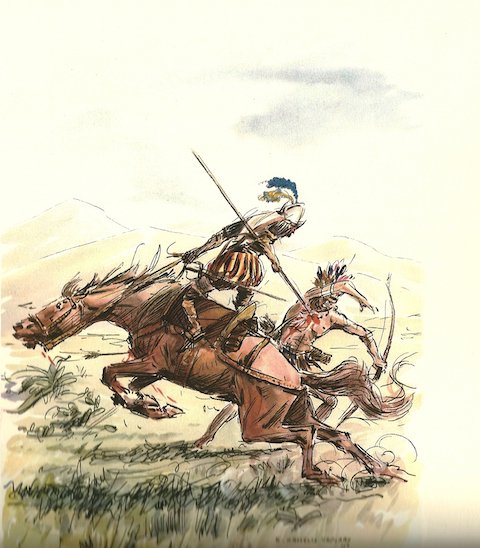
25 May 1519
The Totonac people speak Totonac, which, together with Tepehua, form an isolated language family. Several local varieties of Totonac are not mutually intelligible. The first grammatical and lexical descriptions of Totonac were by Fray Andrés de Olmos
He was a Franciscan priest and extraordinary grammarian and historian of Mexico’s people. He published Arte para aprender la lengua mexicana in 1547 https://bit.ly/2WqIcn4 (three years before the first grammatical description of the French language, to compare)
Olmos contributed to the founding in 1536 of the Colegio de Santa Cruz de Tlatelolco, the first European-based institution of higher learning in the New World. He also published a Nahuatl Vocabulary and wrote several sermons in Nahuatl which have survived
26 May 1519
Tlacochcalcatl “The man from the house of darts” was an Aztec military title or rank; roughly equivalent to the modern title of General. Xicomecóatl was the name of the Tlacochcalcatl of Cempoala https://bit.ly/2YPw38x https://bit.ly/2X2lfDH
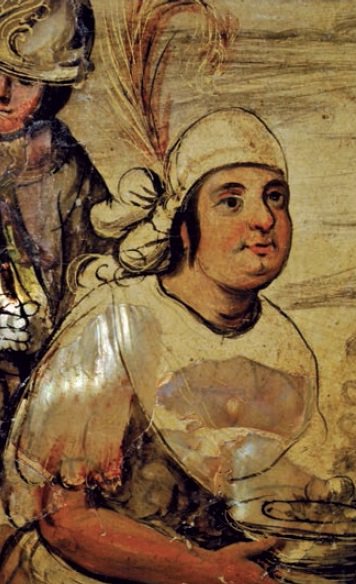
Bernal Díaz del Castillo speaks of homosexuality among the ruling classes, prostitution of young people, and cross-dressing in the area of Cempoala. Totonacs had prostitution houses full of men with painted faces and women’s clothing
27 May 1519
A small delegation from Moctezuma arrived with more gifts.These men explained that Moctezuma still could not meet with Cortés, but this time their position seemed to have softened
Cortés happily accepted the gifts and handed the last three tribute collectors over to these nobles, nephews of Moctezuma, who seemed content when they left. Cortés’s subterfuge and closed-door diplomacy were paying dividends
The respect these noble Aztecs showed Cortés impressed the Totonacs, further buttressing the Spaniards’ reputation and cementing their Totonac allegiance
28 May 1519
Bernal Diaz: “Our allies in the mountains and the inhabitants of Cempoala had stood in no little awe of Moctezuma, as they believed nothing less that he would instantly invade their country with a great army to extirpate them
But, when they found that even several of his relatives arrived, bringing presents, and that they comported themselves so submissively to Cortés, they began more and more to fear us
And the caziques said to one another, these must necessarily be teules, as even Moctezuma himself stood in awe of us and sent us presents. If they had previously formed a great idea of our power, it was now vastly augmented by this unexpected circumstance
«teules» is a word the Spaniards understood from a nahuatl word derived from maya «tzules» that refers to entities of the infraworld inhabited by the gods who hold the earth and others
29 May 1519
The works to build the fort and the town went quickly. Within only a few weeks some of the first buildings were completed; the rest were continuously worked on by any men stationed there. The first colony in New Spain soon became a reality
30 May 1519
Since Cortés landed on the coast of Mexico, he was on the point of committing himself to an enterprise of unknown proportions against an enemy of unknown character and strength. But Moctezuma’s existence was the fact he most needed to know.
A single, supreme objective established itself clearly in his mind. He must reach Moctezuma and somehow induce him to acknowledge the supreme overlordship of Juana and her son Charles, the sovereign rulers of Castile.
31 May 1519
Although everything else was surrounded by innumerable uncertainties, the central objective of Cortés’s Mexican strategy was therefore clearly defined, and he pursued it undeviatingly until it was triumphantly attained
An exceptionally hazardous but care fully calculated military and political exercise, which had to work with great precision to succeed, if Cortés had to make himself master of Moctezuma’s empire in the name of the sovereigns of Castile
1 June 1519
Cortés had to fear from some of his own countrymen too. From the moment of his hasty departure from Santiago, in Cuba, he found himself in a highly equivocal position, both in relation to his immediate superiors and to the Spanish Crown
He knew well enough the grave risks he was running. But to Cortés and his friends—Puertocarrero, the Alvarado brothers, Gonzalo de Sandoval—the risks paled before the attractions of the anticipated prize
Nothing could more quickly obliterate the stigma of treachery and rebellion than a brilliant military success and the acquisition of fabulous riches. If new peoples were won for the Faith, and rich new lands won for the Crown, there was reason to hope
The original defiance of Velázquez would be regarded as no more than a peccadillo, and that Velázquez’s friends and protectors would be silenced by a fait accompli
2 June 1519
The king was the fountainhead of justice. It rested with him to punish the wicked, reward the good, and forgive the occasional act of insubordination—especially when the act was committed in the king’s own interest and for the greater glory of God
3 June 1519
It was well known that God had specifically entrusted the sovereigns of Castile with the task of winning for the Church the peoples of the newly discovered Indies, and that this divine mission had been confirmed by decision of the papacy
Cortés, therefore, would from the first act in the name of the king, in order to further this providential mission; and then, insofar as he had offended against the letter of the law, would throw himself on his mercy
This meant that, from the moment of his departure from Cuba, Cortés totally ignored any claims to jurisdiction of Velázquez or Colón and behaved as if he were directly subordinate to the Crown alone
Any Indians he met as he cruised along the Mexican coast were regarded as being already the vassals of the Crown of Castile, by virtue of the papal donation. Similarly, he took formal possession of the land at the Tabasco River in the name of the Crown in spite of—or, more accurately, precisely because of—the inconvenient fact that Grijalva had already taken formal possession at the same spot, on behalf of the governor of Cuba
4 June 1519
That Cortés and his close associates were banking on eventual vindication by the Crown is further suggested by the jocular exchange on board ship just before the landing at San Juan de Ulúa, as reported by Bernal Diaz:
“Alonso Hernández de Puertocarrero came up to Cortés, quoting a snatch from one of the romances in the Castilian romancero general:
Look on France, Montesinos,
Look on Paris, the city,
Look on the waters of the Duero,
Flowing down into the sea. ”
The lines came from the ballad of Montesinos, exiled from court because of a false accusation by his mortal enemy, Tomillas. Montesinos, the innocent exile, was seeking permission from his father to return to court in disguise and take service with the king
If Montesinos was Cortés, then his enemy Tomillas was Velázquez and Cortés could hope to resolve his difficulties, as Montesinos resolved his, by taking service under the king. “He who takes the king’s pay” continued the ballad “can avenge himself of everything”
Cortés promptly responded in kind, with a quotation from another ballad about another exile: “God give us the same good fortune in fighting as he gave to the Paladin Roland.”
5 June 1519
Success in arms, and resort to the highest authority of all, the king: these were the aims of Cortés and his followers to compound their defiance of Velázquez by a landing which would mark the real beginning of their attempt to conquer an empire
6 June 1519
They were concerned with fame, riches and honor. But behind the willful defiance of the governor of Cuba there existed, at least in Cortés’s mind, a philosophy of conquest and colonization which made his action something more than cheating Velázquez
He entertained, like so many Castilians of his generation, an exalted view of the royal service, and of Castile’s divinely appointed mission. Both the divine and the royal favor would shine on those who won new lands and peoples for God and Castile
7 June 1519
But there was a wrong way, as well as a right way, of going about this great work. In the Antilles, the Castilians had gone about it the wrong way, with disastrous consequences
Cortés had seen with his own eyes how captains and soldiers whose sole concern was the quest for gold and the capture of slaves and booty had destroyed the islands and peoples discovered by Columbus only a generation ago
The extension to the New World of a style of war fare reminiscent of the war against the Moors in medieval Spain had made a desert of a paradise and had left even the Spaniards them selves shiftless and discontented
The failure of Grijalva’s expedition had only served to drive home the lesson already learned by Cortés—that conquest, to achieve any long-term success, required intelligent colonization. Whether Velázquez had learned the same lesson seems doubtful
But in any event Velázquez would be given no opportunity to put the question to the test. Cortés would conquer Mexico, and not only conquer it but settle it as well.
They had first to be neutralized, and the rank and file of the army be induced to support Cortés. The first months on Aztec soil were taken up not only with reconnaissance surveys designed to discover the nature of Moctezuma’s empire and the extent of his power but also with attempts to detach the soldiers from their support to Velázquez’s men. This was done with considerable skill by playing on their desire for gold and land. Bernal Díaz’s account suggests how cleverly Cortés forced the Velázquez faction into the open
8 June 1519
Some careful preliminary maneuvers were needed before Cortés could openly flout Velázquez’s orders by formally founding a town. There was a strong faction of Velázquez’s partisans in the expedition, headed by Montejo and Juan Velázquez de Leon with a demand to return to Cuba—a claim with which Cortés seemed ready to comply—At this point the troops, whose expectations had been aroused and now looked like being dashed, came out with what seemed to be a spontaneous idea that the expedition should continue
9 June 1519
Cortés had been given his cue, and the Velázquez faction had been outmaneuvered. But although the practical difficulties in the way of settlement had been overcome, Cortés had to find some legal justification for disregard of Velázquez’s orders
At this point Cortés’s knowledge of Castilian law came into its own. That great medieval compilation, the Siete Partidas of Alfonso X, dating from 1256-1263, presented a cogent picture of the organic unity that should prevail between the king and his subjects bound together in mutual concern for the upholding of the commonweal against selfish private interest. See https://7partidas.hypotheses.org/a>
10 June 1519
In the context of events in the New World in 1519, Velázquez and his friends could be depicted as self-interested officials, moved by greed and ambition
While Cortés and his army represented the true community, motivated by concern for the commonweal and the desire to serve God and the king
Whereas the private interest of Velázquez busied itself solely with trade and barter, which would fill his own capacious pockets, the commonweal demanded an expedition of conquest and colonization, which would promote the true interests of the realm
11 June 1519
It was in pursuance of this simple but time-honored political philosophy that the remarkable events of June and July, 1519, were enacted. According to the Siete Partidas, the laws could only be set aside by the demand of all the good men of the land
On the soil of New Spain, these were clearly the rank and file of Cortés’s army, and it was in deference to their demand that he now set aside his instructions. They were united in agreeing that the expedition should not return to Cuba
They should remain to attempt the conquest of Moctezuma’s empire and formally constituted themselves a community—the Villa Rica de la Vera Cruz—in order to ensure that the king’s interests were upheld
As a municipality, they then proceeded to appoint the usual municipal officials, the alcaldes and regidores (chief magistrate, town councilors, and a notary)
12 June 1519
From this point, Velázquez’s instructions were regarded as inoperative, and the authority conferred by them on Cortés was deemed to have lapsed. Supreme jurisdiction in Mexico now resided in the municipality of Vera Cruz and the charade was duly completed in May 10th, when the municipality, acting on behalf of Charles and Juana, appointed Cortés town mayor and chief justice of Vera Cruz, and captain of the royal army
13 June 1519
The effect of this brilliant legalistic maneuver was to free Cortés from his obligations to his immediate superior, Velázquez, and to make him directly dependent on the king
But what seemed plausible enough in New Spain was bound to seem highly implausible in Cuba and at the Spanish Court. Clearly it was essential to win support in Spain for an action which Velázquez would certainly represent to the king as an act of open rebellion
14 June 1519
While Cortés was engaged in these maneuvers, the Cempoalan chief arrived, borne in his litter. He requested an audience with Cortés, who summoned Malinche and Aguilar to hear what the Tlacochcalcatl of Cempoala had to say
The chief revealed that already he needed the help which Cortés had promised him. In a hill town called Cingapacinga, some twenty-five miles to the southwest, Aztec warriors were rampaging Totonac villages, destroying their crops and making war on the villagers
According to the Cempoalan chief, this was in retaliation for the Totonacs’ alignment with the Spaniards and for their refusal to pay tributes to the Aztecs. The chief wished to know if Cortés would honor his agreement and go there to stop the marauding Aztecs
15 June 1519
Though he hated to leave the construction of Villa Rica de la Vera Cruz, which was going so well, Cortés understood the importance of maintaining smooth relations with this new ally, so he agreed to help
He kept a small contingent of men to continue the work and to guard their stores and munitions. Then he mustered the bulk of his able conquistadors, including all the cavalry (which was now just fifteen horses, his own having died), and mounted his new horse
Ahead of a group of musketeers and crossbowmen, and leading more than two thousand Cempoalans, Cortés rode forward toward Cingapacinga.
Late in the day Cortés and his troops reached some villages to find other Totonacs already there, ”
but rather than battling Aztec warriors, they appeared to be looting and pillaging defenseless villages, robbing stores of their food, dragging women and children away, and even killing innocent and unarmed people
Through Malinche Cortés discovered that this was an ancient intertribal skirmish over boundaries and land ownership between the Totonacs and the Cingapacingans, and there were no Aztecs anywhere to be found
Enraged, Cortés sent the Cempoalan soldiers away, adding that he would deal with them, and with their chief, when he returned. He rode in and physically subdued the Totonac pillagers, berating them for their behavior and for lying about Aztec involvement
He then told the relieved Cingapacingans that this looting was now at an end. They were safe, and their stolen food and kidnapped people were returned. Again, Cortés’s definitive diplomacy worked: the Cingapacingans agreed right then to become Spanish allies
16 June 1519
Cortés rode back toward Cempoala to deal with the fat chief who had deceived him. During the return, Cortés witnessed one of his own men, a soldier named Mora, coming out of a native house, a freshly caught chicken in each hand
This was the very kind of pillaging he had forbidden and the kind they had just put a stop to. Wanting to set a firm example that such behavior would not be tolerated (and clearly having lost his composure), Cortés ordered to sling a noose around the thief’s neck and string him up from a nearby tree. Stealing chickens was now, apparently, a hanging offense. Mora swung, suspended in the air and clutching at the noose, struggling for his last breaths
Just then Pedro Alvarado arrived at a gallop and, skidding to a halt, slashed the rope in two, sending Mora to the ground with a thud, alive. Alvarado took private counsel with Cortés, explaining that they needed all the soldiers they had and that this man had certainly learned his lesson, as had any witnesses. Cortés, reasonable, conceded, and they remounted and rode back toward Villa Rica and Cempoala
17 June 1519
Cortés called together the chiefs of all the neighboring towns (including the chief of Cempoala and the cacique of Cingapacinga) and held a meeting
Before witnesses, Cortés told them that he could assist them, and help keep peace in the region, only under certain conditions, which they must agree to and live by. First, they must stop warring among themselves
The long-standing feuds must be forgotten and a new alliance formed. In principle (and apparently in practice, because according to chroniclers, this pact remained intact, never broken by either party), the Cempoalans and the Cingapacingans were to be friends
Cortés is said to have actually had the leaders shake hands on it, an uncustomary gesture that would have seemed at least strange, and probably awkward and meaningless, to the Indians.
18 June 1519
Seeing that local border tensions were pacified, Cortés determined that the time was right for full-fledged conversion
19 June 2019
Through Malinche, he delivered his “customary exposition of our holy faith, and his injunctions to give up human sacrifice and robbery and the foul practice of sodomy,* and to cease worshipping their accursed idols.”
Cortés explained that only if they agreed to all of this would he assist them. If they did not, he would leave them as they were before, helplessly subjugated, vassals under the rule of the Aztecs
If they would cast aside their own beliefs and follow the belief of the one true God, they would become vassals of Spain (and receive other benefits as well, like everlasting life)
Then, as he always favored action over words alone, Cortés had the chiefs bring all their soldiers and civilians together and assemble in the central square of Cempoala. Villagers had also arrived filling the pyramid compound where all religious ritual took place
20 June 2019
Hoping to make amends, a bit sheepish and contrite, the Cempoalan chief presented Cortés with 8 native maidens, the daughters of chiefs, saying that they wished to have the Spaniards as brothers and that he hoped these women would bear them children
One of these women Cortés would give to Alonso Hernández Puertocarrero, which was only fitting, seeing that Cortés had given him but then taken back Malinche. With skillful improvisation, Cortés used the gift as leverage
He said that he much appreciated the gesture, but that the Spaniards could accept these women only if they became baptized as Christians. Moreover, he reiterated his condition that all the Indians of the region entirely give up the practice of human sacrifice
Every day Cortés and his men had witnessed this act, this barbarity, and it simply must cease, or he could not in good conscience be their ally and protect them from their “false beliefs.”
21 June 2019
On the issue of removing their idols from the temples, the Cempoalan chiefs and priests argued vigorously, saying that these gods were responsible for bringing them good health, plentiful harvests, suitable weather, and indeed, life itself
It would be wrong to remove them. Cortés explained that, if they would not do it themselves, he was going to have some of his men ascend the pyramids and perform the service for them
The Totonac people, fearing that their world would come to an end if their idols were destroyed, began to shriek and howl and wail, and Xicomecóatl sent armed warriors to stand at the foot of the temple and defend it.
22 June 2019
Bernal Díaz also witnessed his share: “Every day they sacrificed before our eyes three, four, or five Indians, whose hearts were offered to those idols and whose blood was plastered on the walls.”
“The feet, arms, and legs of their victims were cut off and eaten, just as we eat beef from the butcher in our country. I even believe they sold it in the tianguez or markets.”
23 June 2019
Cortés would not be bullied; nor would he compromise. He marched fifty of his soldiers forward, armed and ready, swords drawn. As they neared the steps, the Totonacs strung their bows and aimed
Then Cortés turned on Xicomecóatl himself and held him at swordpoint. Through Malinche he explained in no uncertain terms that his men must be allowed to pass or Xicomecóatl and his priests would be killed on the spot
The air went tense and silent, all at an impasse, but the fat chief finally raised his hand. He called to his warriors to lay down their bows and spears and move aside
As the fifty Spaniards ran up the stone steps, all of the Totonac religious leaders and thousands of terrified onlookers waited below for their world to come crashing down
The Spanish soldiers reached the top and paused before the giant stone idols, which they viewed as horrific and macabre. Among them were a “hideously ugly” half-man, half-dog figure and a large, ferocious-looking dragon
Working together in teams, the Spaniards heaved the great carved-stone figures to the edge of the temple platform and then sent them rumbling down the steep steps and shattering into pieces
Horrified, the chiefs and priests threw their hands before their eyes and turned away, and the general wailing intensified. The assembled prayed to their gods to forgive this brazen act of the Spaniards, for it was not their fault.
24 June 2019
When the dust from the crumbling idols cleared, the Totonacs realized, with some confusion and clear relief, that their world had not come to a cataclysmic end, at least not instantaneously
But this act of conversion, Cortés-style, was the beginning of the end of their religion and their culture, and a mood of somber resignation fell about Cempoala as Cortés ordered the remains of the fragmented sculptures taken away and burned
Adding deep insult to this injury, Cortés forced the eight priests (papas) who were entrusted with the care of the shrine and the idols to perform the task of removing and burning them. These men walked with their heads down, moaning in lamentation
They wore long black cloaks, and their hair, which they never cut, was matted and congealed with sacrificial blood, and their ears were sliced from sacrificial self-mutilation
25 June 2019
Cortés then directed the transformation of the pyramid temple into a Christian place of worship, calling on all the town’s stoneworkers to assist him
They ascended the steps with wooden and earthen containers of lime and whitewashed the entire temple area, scrubbing the encrusted dried blood from floors and walls and from the surface of the sacrificial stone. They burned incense to eradicate the smell of blood
Then Cortés had an altar erected, laid over with fine linens and sweet-smelling roses. He called on four of the priests to guard and care for the new shrine, and as part of their conversion, their long hair, which fell to the ground on some of them, was cut off and they were given white robes to wear instead of their black ones. These new keepers were instructed in the art of candle-making and told to keep some always aflame on the altar, illuminating the wooden cross that had been raised there and the figure of Mary
Remarkably, given Cortés’s usual thoroughness in such matters, these Totonac priests were not baptized
26 June 2019
To finalize the transfer of religions, Cortés asked Father Olmedo to say mass before all the Totonac chiefs, while the throngs of onlookers assembled below gazed up and listened intently to the Spanish language, translated by Malinche
27 June 2019
Finally Cortés insisted, as a condition of his accepting them, that the eight virgin maidens recently given to him by the fat chief be briefed in the teachings of Christianity and baptized
Cortés distributed the girls among his men, descended the steps of his new pyramid-church, and headed back to Villa Rica. As he and his cavalry rode away, the flames from the burning idols still smoldered, black smoke smearing the skyline of the coastal plain.
28 June 1519
Back at Villa Rica, by this day Cortés’s expedition had successfully finished the works to build the fort and the town. He had founded the first Spanish colony in New Spain https://t.co/0h73KPvOnt
This very same day in Frankfurt, Germany, the imperial electors gave Charles I of Spain the Holy Roman Emperor crown. He defeated the candidacies of Frederick III, Elector of Saxony, Francis I, King of France, and Henry VIII, King of England
Charles V revitalized the medieval concept of the universal monarchy of Charlemagne and spent most of his reign defending the integrity of the Holy Roman Empire from the Protestant Reformation, the expansion of the Ottoman Empire and a series of wars with France
29 June 1519
Charles V had united not only Spain to Germany, but also the Netherlands, a part of France and two thirds of Italy. His ambitious humanist advisers saw in him the vehicle for reviving Charlemagne’s ambition for a single political power in Europe
Charles came closer to translating the old dream of a united federal Europe into a political reality than at any point before the existence of the EU. In 1519
Charles may not have exactly “possessed” Germany, as Cortes claims, but he was certainly its “Imperator”
And, for the first time since Charlemagne, this Emperor could, with some degree of plausibility, make some claim to the title which the Roman emperor Antoninus Pius had assumed in the first century A.D.: “dominus totius orbis” – “Lord of All the World”
30 June 1519
It is no coincidence that Cortés, who displayed both a remarkable knowledge of European affairs and an ability to manipulate them for his own ends, should have claimed that Moctezuma’s vassals also looked upon him as “Lord of the World”
From the beginning, then, the conquest had been set up as a conflict, not over an obscure – obscure at least for a European – corner of the world, but as a competition for universal monarchy
1 July 1519
Cortés was intrigued to learn that a ship from Cuba had just arrived at San Juan de Ulúa commanded by Francisco de Saucedo bearing the not unexpected news that Velázquez, by royal decree of November 13, 1518, had been appointed adelantado of Yucatán, and Velázquez had been granted the right to conquer and settle too. Now that Velázquez had obtained his authorization, Cortés’s action seemed to lack even the shadow of legality
2 July 1519
Everything now depended on the successful presentation of Cortés case at Court, where the Fonseca group would certainly do all in its power to destroy him
If possible, Charles V and his advisers must be reached and won over before they had time to learn from Velázquez himself of Cortés’s act of rebellion. For this purpose, Puertocarrero and Montejo, who had been detached from the Velázquez faction, were appointed procuradores, or representatives, of Vera Cruz, with full powers to present the municipality’s case to the king in person
3 July 1519
To assist them in their mission, they were to take with them, as a gift for the king, all the gold and jewels brought to Cortés by Moctezuma’s envoys, together with the traditional royal fifth of all the booty so far acquired
They took with them, too, such documentation as was needed to justify their cause. This documentation included the “lost” First Letter of Relation of Cortés —unless, as is perfectly conceivable, he never wrote such a letter, for it would necessarily have involved a number of personal explanations which could well have offered embarrassing hostages to fortune
4 July 1519
The most important document carried to Spain by Puertocarrero and Montejo was the letter from the new municipality of Vera Cruz, addressed to Charles V and her mother Juana I of Castille https://t.co/k9kEk3G7d6
This letter, which customarily replaces Cortes’s “missing” First Letter, bears all the stamp of his personality, and was no doubt written largely to his dictation. It should therefore be read, as it was written, not as an accurate historical narrative but as a brilliant piece of special pleading, designed to justify an act of rebellion and to press the claims of Cortés against those of the governor of Cuba https://t.co/sEjW4P80QQ
5 July 1519
For all Cortés’s eager insistence that he was providing a “true” relation, he displayed a masterly capacity for suppression of evidence and ingenious distortion
Great care was taken to play down the expeditions of Hernández de Córdoba and Grijalva, and the awkward fact that the latter had taken formal possession of the land was quietly ignored. The letter also missed no opportunity to blacken the reputation of Velázquez —”moved more by cupidity than any other passion”—and to suggest that his financial contribution to the expedition was insignificant. The persistent denigration of Velázquez only served to emphasize by contrast, the loyalty and the high ideals of Cortés himself as a man passionately determined to serve God and the king by extirpating idolatry, converting the heathen and conquering rich new lands for the Crown of Castile
At the same time, Cortés was careful to imply that he broke with Velázquez’s instructions only under pressure from the popular will, as represented by the army. It was the soldiers, eager to convert a trading expedition into a military and colonizing enterprise, who had demanded a change of plan; and Cortés, after due deliberation, had accepted their demand as conducive to the royal interest
See Cortés, Velázquez and Charles V: Introductory Essay by J. H. Elliott https://t.co/n7Ix1MyCe8 in Letters from Mexico. Translated, edited, and with a new introduction by Anthony Pagden. Revised edition published by Yale University Press in 1986

6 July 1519
Having offered this tendentious explanation of the founding of Vera Cruz, the letter then dwelt at some length on the alleged riches of the country and on the abominable customs of its inhabitants
The object of this was to appeal both to Charles’s cupidity— an appeal skillfully reinforced by the gift of Moctezuma’s treasures—and to his sense of religious obligation, as a ruler entrusted by God and the Pope with the duty of winning new peoples to the Faith
But the letter’s real climax came after the description of Mexico, and consisted of a direct appeal to Charles and Juana “on no account to give or grant concessions to Diego Velázquez or judicial powers; and if any shall have been given him, that they be revoked”
Since the arrival of Saucedo, Cortés was perfectly well aware that Velázquez’s commission had in fact already arrived. Ignorance, however, was the better policy; and Cortés drove home his request with a final denunciation of the governor of Cuba as a man of such patent wickedness as to make him totally unfitted to receive the least token of royal favor.
—The municipality letter was signed this day
7 July 1519
Cortés commissioned Diego de Ordaz and Francisco de Montejo, who were thorough men of business to see what they could make out of those men whom they might expect would demand their share of gold instead of sending all to the emperor
This was accordingly done, and they represented to every one that we were desirous of sending his majesty the emperor a present in gold, which, considering it was the first, ought indeed to be something valuable
In order, however, to make this possible, nothing remained but that each one should give up his share of the gold which had been made up to this moment, A great number of officers and soldiers had already signed their hands to that effect; yet every one was at liberty to act herein as he thought proper. Here was the paper, which every one who chose could put his hand to. Every one, without exception, signed his name to the document
8 July 1519
The original texts of the Cartas de relación no longer survive. There are, however, two manuscript compilations. One in Vienna (ms. SN 1600) contains the only known transcript of the letter from the municipal council of the town of Veracruz
The codex was first discovered in 1777 by the Scottish historian William Robertson, who, in his researches for The History of America, had failed to locate in Spain the missing First Letter
He reasoned that as Charles V was preparing to leave for Germany at the time when Cortés’ representatives arrived in Spain, the missing letter might be in Vienna. He then searched the Imperial Library and discovered the codex
There is another, probably slightly later, copy in the Biblioteca Nacional in Madrid (ms. 3020), of the four letters by Cortes, together with accounts (relaciones) by Pedro de Alvarado, and Diego de Godoy, together with a number of other documents
It contains information which is lacking from the Vienna Codex, among them the place and date of the Fifth Letter
9 July 1519
The letter from the new municipality of Vera Cruz started: MOST HIGH, MIGHTY AND EXCELLENT PRINCES, MOST CATHOLIC AND POWERFUL KINGS AND SOVEREIGNS:
We have reason to believe that Your Royal Highnesses have been informed, by letters of Diego Velázquez, the admiral’s lieutenant in the island of Fernandina (Cuba), of a new land that was discovered in these parts some two years ago more or less, and which was first called Cozumel and later Yucatan, without it being either the one or the other as Your Royal Highnesses shall see from our report https://bit.ly/2LII24v
10 July 1519
The letter ends: “The representatives, inhabitants and citizens of this town have likewise asked us, in the aforementioned petition, to entreat Your Majesties on their behalf to order and provide a decree and letters patent in favor of Fernando Cortés, captain and chief justice of Your Highnesses, so that he may govern us with justice until this land is conquered and pacified, and for as long as Your Majesties may see fit, knowing him to be a person well suited for such a position.
Which petition and request we send to Your Majesties with these our representatives and humbly supplicate Your Royal Highnesses to grant us this and all the other favors which in the name of this council and town may be asked of You by the aforementioned representatives, and that You hold us as Your most loyal vassals, as we have been and always shall be
The gold, silver, jewels, bucklers and garments which we are sending to Your Royal Highnesses with these representatives, over and above the one-fifth which belongs to Your Majesty, Fernando Cortés and the council of this town offer in Your service and are sending together with a list signed by the same representatives as Your Royal Highnesses may observe. From the Rica Villa de la Vera Cruz, the tenth day of July, 1519”
11 July 1519
The gold, jewels, precious stones and articles of featherwork which have been acquired in these newly discovered lands since our arrival here, which you, Alonso Fernandez Puerto Carrero and Francisco de Montejo, who go as representatives of this Villa Rica de la Vera Cruz to the Very Excellent Princes and Most Catholic and Very Great Kings and Sovereigns, the Queen Dona Juana and the King, Don Carlos her son, are the following:
First a large gold wheel with a design of monsters on it and worked all over with foliage. This weighed 3,800 pesos de oro. From this wheel, because it was the best that has been found here and of the finest gold, a fifth was taken for Their Highnesses; this amounted to two thousand castellanos which belonged to Them of Their fifth and Royal privilege according to the stipulation that the captain Fernando Cortes brought from the Hieronymite Fathers who reside on the island of Hispaniola and on the other islands.
The eighteen hundred pesos that remained and all the rest that goes to make up 1,200 pesos, the council of this town bequeath to Their Highnesses, together with everything else mentioned in this list, which belonged to the people of the aforementioned town
Note: The maravedi was the basic unit of Spanish currency at this time: 450 maravedis of gold and silver, equivalent to 42.29 grams of pure silver, made a castellano or peso de oro. This was divided into eight reales (or tomines), eleven of which made a ducado or ducat. The ducat, modeled on the Venetian coin, was also called an excelente de Granada. It was 23 3/4 carats fine and was tariffed at 375 maravedis. In 1537 the escudo (22 carats fine and tariffed at 350 maravedis) was substituted for the ducat, though the latter continued to be used as a unit of account. In 1548 an increased vellon circulation was authorized, and in 1552 the silver content of the vellon was reduced from 7 to 5 1/2 grains fine. In the 1520s copper began to be added to the peso de oro in America, producing the oro de tepuzque. This was done in an attempt to combat the inflated prices charged by Spanish merchants. Ultimately, the coin’s value dropped to 272 maravedis (John Lynch, Spain under the Hapsburgs, appendix I. Felipe Mateu y Llopes, La moneda espanola, pp. 231-274). An arroba is equivalent to approximately 14.76 liters, but this may vary regionally and according to the liquid.
12 July 1519
Item: Two necklaces of gold and stone mosaic, one of which has eight strings of 232 red jewels and 163 green jewels. Hanging from the border of this necklace are twenty-seven small gold bells; and in the center of them are four figures in large stones inlaid with gold. From each of the two in the center hang single pendants, while from each of the ends hang four double pendants.
The other necklace has four strings of 102 red jewels and 172 which appear to be green in color; around these stones there are twenty-six small gold bells. In this necklace there are ten large stones inlaid with gold from which hang 142 pendants.
13 July 1519
Item: Four pairs of screens, two pairs being of fine gold leaf with trimmings of yellow deerskin, and the other two of fine silver leaf with trimmings in white deerskin. The remainder are of plumes of various colors, and very well made
From each of these hang sixteen small gold bells, all with red deerskin.
Another item: One hundred pesos de oro for melting, so that Their Highnesses may see how the gold is taken from the mines here
Another item: In a box, a large piece of featherwork, lined with animal skin which, in color, seems like that of a marten. Fastened to this piece, and in the center of it, is a large disk of gold which weighed sixty pesos de oro, and a piece of blue and red stone mosaic in the shape of a wheel, and an- other piece of stone mosaic, of a reddish color; and at the end of the piece there is another piece of colored featherwork that hangs from it
14 July 1519
Item: A fan of colored featherwork with 37 small rods cased in gold
Another item: A large piece of colored featherwork for the head and encircled by 68 small pieces of gold, each as large as a half cuarto. Beneath them are 20 little gold towers
Item: A miter of blue stone mosaic with a design of monsters in the center. It is lined with an animal skin which by its color appears to be that of a marten, and has a small piece of featherwork which, together with the one mentioned above, is of the same miter
Item: Four harpoons of featherwork with their stone heads fastened by a gold thread, and a jeweled scepter with rings of gold and the rest of featherwork.
15 July 1519
In Tenochtitlan, Moctezuma and his people lived through days of intense fear, because it was now certain that the strangers intended to march on the Aztec capital. The grand tlatoani had already sent out wizards and magicians
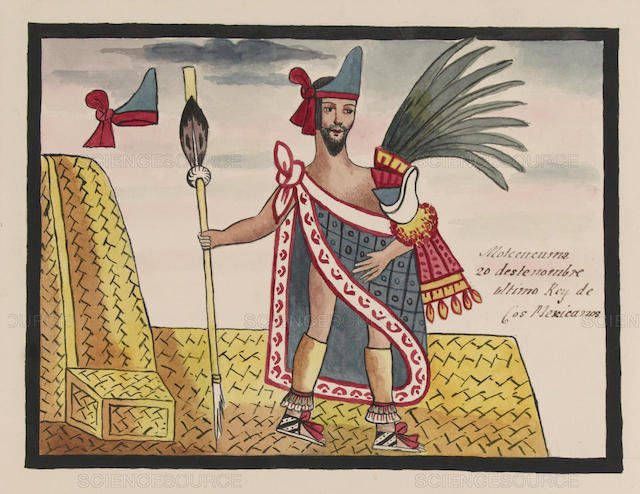
Now Moctezuma learnt of the magicians’s failure to work some charm against them, or do them some mischief. They were unable to cause them to break out in sores, or injure them, or to cause them to fall sick, or die, or return to their own land
Moctezuma was distraught and bewildered; he was filled with terror, not knowing what would happen to the city. The people were also terrified, debating the news among themselves. Moctezuma thought of fleeing
16 July 1519
But Moctezuma could not run away and hide. He had lost his strength and his spirit, and could do nothing. The magicians’ words had overwhelmed his heart; they had vanquished his heart and thrown him into confusion
He was weak and listless and too uncertain to make a decision. Therefore Moctezuma did nothing but resign himself and wait for them to come. He mastered his heart at last, and waited for whatever was to happen
17 July 1519
It was said to Moctezuma how the Spaniards brought a Mexican Indian as interpreter, named Marina, a neighbor of the town of Teticpac, on the Coatzacoalcos region, who said in the Mexican language everything that Cortés asked her
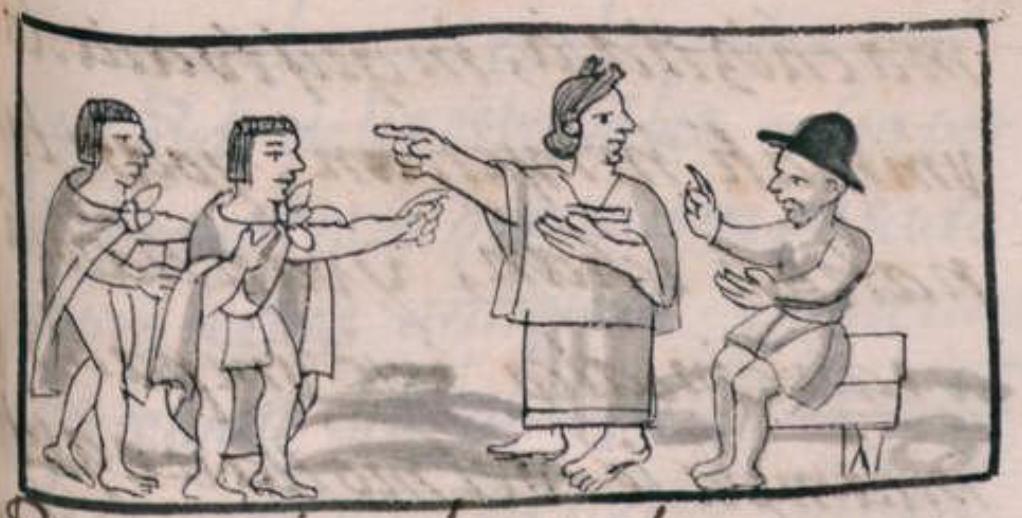
Moctezuma wondered how a woman among his own had brought the Spaniards and served as interpreter. He was terrified of the disadvantage of the fact that the newcomers had an interpreter of their own people
18 July 1519
In Spain, from July 1519 to January 1520 Bartolomé Las Casas presented his proposal for peaceful conversion and Spanish coexistence with the indigenous peoples to the court of Charles V

He argued to the Council of Indies against enslaving the inhabitants, preferring to implement a system in which the inhabitants paid tribute directly to the crown
Specifically, he sought permission to penetrate the land of Cumaná, in now Venezuela, with 50 men to establish a peaceful settlement of 10,000 Indians, which would serve as a base for future exploration and as a source of tribute for the crown
He wanted a grant of 1,000 leagues of coastline for settlement, and he estimated the revenue of this settlement to be at least 15,000 ducats by the third year, and 60,000 ducats by the end of the decade
He clearly wanted his plan to appeal to officials at court whose main interest was money. The utopian scheme was approved by the council with the support of chancellor Gattinara. It was a complete failure when put into practice
After that, Las Casas entered a Dominican monastery for 10 years. Then he returned with new plans for peaceful colonization of the Indies
19 July 1519
Cortés gathered his captains and loyalists and explained that they must immediately dispatch one of their ships directly to Spain. Cortés chose captains Puertocarrero and Montejo for the journey
With the expert and experienced pilot Alaminos at the helm, their orders were to sail as fast as possible to Spain, avoiding any unnecessary stops or delays
Cortés well knew that, even under perfect sailing conditions, the treasure ship would take a few months to reach Spain, and that no response would reach him until spring of the following year, at the earliest
This ship would be leaving for Spain in few days, nearly two months past the ideal departure weather. Cortés’s men must load the ship with every ounce of treasure they had procured along the way
20 July 1519
Puertocarrero and Montejo were carefully chosen. Cortés trusted Puertocarrero as a friend, and by sending Montejo, he dispensed with an influential Velázquez agitator, while providing the appearance of equality in his choice
They were sent not simply as captains and envoys but as official procuradores, civic representatives of the newly founded Villa Rica de la Vera Cruz. This designation gave the appearance of legitimacy, even if it was legally questionable
21 July 1519
When some of the men balked, protesting that they were required to send only the Royal Fifth, and would be giving away their hard-won spoils, Cortés argued that he understood, but in order to impress the emperor and win good graces for their continued mission, they must send a treasure literally fit for a king. Anything less would potentially undermine their credibility
22 July 1519
Cortés was preparing the treasure ship, with the implication that there was plenty more where this came from, and the tacit assurance that Cortés and his men were going after it, right into the heart of the Aztec empire
The first letter to Spain contained an itemized list, down to the last golden bird and tiny bell. It continued like this:
– Item: A bracelet of blue jewels and, in addition, a small piece of black featherwork and with other colors
23 July 1519
Item: A large pair of sandals of leather whose color resembles that of a marten. The soles are white and sown with gold thread
Furthermore, a mirror set in a piece of blue and red jewelry, with a piece of featherwork and two strips of red leather attached to it, together with a skin which seems to be from those same martens
24 July 1519
Furthermore, a large silver wheel which weighed 48 silver marks, and also some bracelets, some beaten [silver] leaves; and one mark 5 ounces and 40 adarmes of silver; and a large buckler and another small one of silver
and another two bucklers which appear to be silver and which weighed six marks and two ounces; and another buckler, which likewise appears to be of silver, which weighed one mark and seven ounces, which is in all sixty-two marks of silver.
25 July 1519
Cortés had by now learned enough about Moctezuma and his kingdom to know how they were likely to react to an armed Castilian arrival in Tenochtitlan
Thus Andrés de Tapia wrote that Marina/Malintzin told Cortés that Moctezuma and the Mexica looked on themselves as newcomers in the land which they now ruled; that they had established an empire under the pretext of preaching a religion; that they offered peace to those from whom they received tribute; and that they lived on an island in a lake. This must have confirmed the information made available by the chief of Cempoala
26 July 1519
Everything being now ready for the departure of the treasure ship, father Olmedo said mass, and they set sail from San Juan de Ulúa, with Alaminos at the helm
They set out on the Santa María de la Concepción, Cortés’s prized flagship. Their orders were to sail as fast as possible to Spain, avoiding any unnecessary stops or delays
But Montejo convinced Alaminos to alter their proposed course and stop for a short period in Cuba so that he could tidy up some business affairs at one of his properties in a place called Marién
As soon as they boarded the flagship once more and sailed for Spain, a servant of Montejo spoke with Velázquez in Santiago. Now the governor of Cuba had confirmation that the new found lands were loaded with precious metals and that his long-held suspicions about the rebellious Cortés had been well founded. Velázquez launched two fast ships to overtake the Santa María, but pilot Alaminos had already made it to the powerful Gulf Stream and was gone
When Velázquez’s chase ships returned empty-handed, he decided to send a military force to capture or kill Cortés —whichever was most convenient— and reestablish the area under his control
The man he chose for the duty was his friend and trusted lieutenant Pánfilo de Narváez, who had helped him conquer Cuba in the first place, with Cortés under him
Finally, the treasure and the memorial letter sent by the municipal council of Vera Cruz, were received by the King Carlos, in Valladolid, in Holy Week, in the beginning of the month of April 1520
27 July 1519
Uneasiness simmered among some of the colony as they watched the pilot Alaminos sail away. Some diehard Velázquez loyalists grumbled, longing to board ships to return to Cuba, to their wives and farms and the creature comforts of home
This desire was reinforced when Cortés’s intentions to march inland became obvious to them. They had been on the coast for two months. They were hungry and tired, and some were still run down with tropical malaises. They wanted to go home
28 July 1519
28 July 1519: Initially Cortés feigned sympathy, saying that any who wished to leave should be allowed to, but he soon reversed that decision
Cortés explained that for the venture upon which they were about to embark, he would need every last man to combat the unknown dangers ahead. But mutiny hung in the air
29 July 1519
A small contingent of Velázquez supporters (championed by Pedro Escudero, Velázquez de León, Diego de Ordaz, and an able pilot named Gonzalo de Umbria) met secretly and plotted to board one of the most seaworthy brigantines, kill the captain, seize the ship, and sail after the treasure ship—which they would overtake and return to Velázquez. During the night they commenced preparations, loading some food, water, and oil, and planned a silent midnight departure
30 July 1519
One of the original conspirators, Bernardino de Coria, began to repent, called upon Cortes at midnight, and discovered the whole plot to his captain-general. He was right to have feared Cortés
Cortés had all the known plotters arrested and, to send a message to his troops, imposed immediate, harsh sentences. Chief instigators Pedro Escudero and Juan Cermeño were sentenced to be hung; the pilot Gonzalo de Umbria to have his feet cut off; one of the lesser sailors was to be given two hundred lashes, in full view of the troops; and one of the expedition’s priests, Juan Díaz, was imprisoned for a time and threatened with hanging. (Ostensibly Cortés wished him to be “scared to death.”)
31 July 1519
Cortés said of his decision, “It would be better not to know how to write. Then one would not have to sign death sentences.” With that, Escudero and Cermeño swung from the gallows
But not all sentences were carried out as originally conceived. Part of Umbria’s feet, his toes, were cut off, but he continued on the journey, and the rest of the men were held behind bars but eventually released, having learned their lesson
Still, the mutiny unsettled Cortés. He could risk no further insubordination and knew that he must eradicate all enticements to future discord
Article about the History of the conquest of New Spain or Book XII of the General History of the things of New Spain or Florentine Codex, by Fray Bernardino de Sahagún. See many versions of this amazing book https://bit.ly/2KdZ746
1 August 1519
The sentences being executed, Cortés immediately set out for Cempoala, the city of his Totonac ally Xicomecóatl, having previously ordered that 200 men with all horses should follow him. The distance to this place was a good 20 miles
Pedro de Alvarado was absent during this time, having three days beforehand been sent with 200 men into the mountains in search of provisions, which were extremely scarce
Orders were, therefore, left behind for him to march to Cempoala on his return, where arrangements would be made for our further route to Mexico. Alvarado, consequently, was not present when the executions took place
2 August 1519
Bernal Díaz del Castillo: “How we came to the resolution of marching to Mexico, and of destroying all our vessels, which was done with the sanction and by the advice of all Cortés’ true adherents:
While preparations were going on at Cempoala for our march into the interior, numerous consultations were held with Cortés respecting everything connected with it, we, his trustworthy adherents, proposed that all the vessels should be run on shore, in order at once to cut off all possibility of further mutiny, when we should have advanced far into the interior of the country. In which case, the pilots and sailors would be of greater use to us than by idling their time away in the harbour
I am well aware that the idea of destroying our vessels originated with Cortés himself, and that he merely shoved it on our shoulders for this reason, that if payment for the vessels should be demanded of him, he could throw the blame on us, and say that all was done at our own request; so that we both individually and collectively should have to assist in repaying the damages. This resolution was immediately adopted, and Cortés ordered the alguacil-major, Juan de Escalante, a young man of very great courage, and who was a close adherer to him, utterly hating Diego Velázquez because he had neglected to give him any considerable encomienda in Cuba, to take all the anchors, ropes, sails, in short everything that might be of use to us out of the vessels, and run the latter all on shore, with the exception of the boats. The pilots, the old ships’ masters, and those seamen who were unable to make the campaign with us, were to remain behind in the town, and employ themselves in catching fish with our two drag-nets in the harbour, where the former were in great abundance.”
3 August 1519
But Cortés expressly declares in his second letter to the emperor, that he ordered the vessels to be sunk, without the knowledge of his men, from the apprehension, that, if the means of escape were open, the timid and disaffected might, at some future time, avail themselves of them. In an act of incredible, calculated daring, Cortés confided in his trusted shipmasters and had them bore holes in the bottoms of the boats so that they began to list and groan and founder in the water. Then Cortés gathered his troops. The hulls of some ships were worm-eaten, he explained, and others were weakened by the heavy gales and pounding surf of their long journeys.
He ordered the boats stripped of sails and cables, cordage and nails, and stowed all the usable hardware in the fort on the promontory above the beach. Then Cortés gave the order to have all the ships run aground or sunk. He scuttled his fleet
4 August 1519
Montejo y Puertocarrero, on their visit to Spain, stated, in their depositions, that the captain-general destroyed the fleet on information received from the pilots
Narváez in his accusation of Cortés, and Las Casas, speak of the act in terms of unqualified reprobation, charging him, moreover, with bribing the pilots to bore holes in the bottoms of the ships, in order to disable them
5 August 1519
The order to have all the ships run aground or sunk, so remarkable as the act of one individual, becomes absolutely incredible, when considered as the result of so many independent wills
It is not improbable, that Bernal Diaz, from his known devotion to the cause, may have been one of the few to whom Cortés confided his purpose
6 August 1519
As the last of the great ships fell below the level of the horizon and disappeared into the bottom of the dark gulf waters, Cortés stood with his men. He had staked everything, his very life and all of theirs, on the future
He later reflected that they now had “nothing to rely on save their own hands—and the certainty that they must either win the land or die in the attempt.” There would be no turning back
7 August 1519
After the vessels had been run ashore,
Cortés addressed his men: “The blessed Saviour would carry us victorious through every battle with our enemies. Indeed, this assurance must be our stay, for every other refuge is now cut off, but that afforded by the Providence of God, and your own stout hearts.” He ended by comparing their achievements to those of the ancient Romans. Cortés was, indeed, master of that eloquence which went to the soldiers’ hearts
For their sympathies were his, and he shared in that romantic spirit of adventure which belonged to them. “We are ready to obey you,” they cried as with one voice. “Our fortunes, for better or worse, are cast with yours.”
8 August 1519
Cortés now set about making preparations for an inland march, assaying his available troops and weaponry. He would need to leave some soldiers in Villa Rica to guard the fortress and continue working on the buildings
The weak, wounded, and sick would remain to recuperate, given the likely difficulty of the mountains, which he could see in the distance. As many as 150 would stay behind, under the command of Juan de Escalante
Escalante was entrusted to keep his men fit and ready, to maintain convivial relations with the coastal Indians, and to survey the gulf waters for any maritime activity, friendly or hostile
9 August 1519
While at Cempoala, Cortés received a message from Escalante, his commander at Villa Rica, informing him there were four strange ships hovering off the coast, and that they took no notice of his repeated signals
This intelligence greatly alarmed the general, who feared they might be a squadron sent by the governor of Cuba, to interfere with his movements
In much haste, he set out at the head of a few horsemen, and, ordering a party of light infantry to follow, posted back to Villa Rica
The rest of the army he left in charge of Alvarado and of Gonzalo de Sandoval, a young officer, who had begun to give evidence of the uncommon qualities which have secured to him so distinguished a rank among the conquerors of Mexico
10 August 1519
Escalante would have persuaded the general, on his reaching the town, to take some rest, and allow him to go in search of the strangers. But Cortés replied with the homely proverb, “A wounded hare takes no nap,” and, without stopping to refresh himself or his men, pushed on three or four leagues to the north, where he understood the ships were at anchor. On the way, he fell in with three Spaniards, just landed from them
They belonged to a squadron fitted out by Francisco de Garay, governor of Jamaica. Garay, the year previous, had visited the Florida coast, and obtained from Spain authority over the countries he might discover in that vicinity
The three men, consisting of a notary and two witnesses, had been sent on shore to warn their countrymen under Cortés to desist from what was considered an encroachment on the territories of Garay
That very same day, 5 ships departed from Seville, Spain, led by another Hernando, Magellan. 3 years later, one of those ships, Victoria, returned to Seville, resulting in the first circumnavigation of the Earth, completed by Juan Sebastián Elcano
11 August 1519
Cortés saw at once there was nothing to apprehend from this quarter. He would have been glad, if he could, have induced the crews of the ships to join his expedition. He found no difficulty in persuading the notary and his companions
But when he came in sight of the vessels, the people on board, distrusting the good terms on which their comrades appeared to be with the Spaniards, refused to send their boat ashore. In this dilemma, Cortés had recourse to a stratagem
He ordered three of his own men to exchange dresses with the new comers. He then drew off his little band in sight of the vessels, affecting to return to the city.
In the night, however, he came back to the same place, and lay in ambush, directing the disguised Spaniards, when the morning broke, and they could be discerned, to make signals to those on board
The artifice succeeded. A boat put off, filled with armed men, and three or four leaped on shore. But they soon detected the deceit, and Cortés, springing from his ambush, made them prisoners.
Their comrades in the boat, alarmed, pushed off, at once, for the vessels, which soon got under way, leaving those on shore to their fate
Thus ended the affair. Cortés returned to Cempoala, with the addition of half a dozen able-bodied recruits, and, what was of more importance, relieved in his own mind from the apprehension of interference with his operations.
12 August 1519
Cortés now made arrangements for his speedy departure from the Totonac capital. The journey up and over the mountains promised to be arduous, and Cortés requested assistance from the Cempoalan leaders
They agreed to provide him with fifty experienced warriors and, more important, a few hundred porters to help carry gear and weaponry, including the heavy falconets, which fired three-pound balls or even smooth, round stones if munitions fell short
Most of the larger cannons, the lombards, were too heavy to portage even with the addition of native porters and the remaining one hundred or so Cuban servants, so the bulk of them were left behind to shore up the fortress at Vera Cruz
To assist the porters and speed travel, Cortés commissioned one of his carpenters to construct a few wheeled wooden carts that could be heavily loaded and pulled. These tools of war were the first wheeled vehicles ever used in Mesoamerica
13 August 1519
The forces reserved for the expedition amounted to about 400 foot and 15 horse, with 7 pieces of artillery. Cortés obtained, also, 1300 Indian warriors, and 1000 tamanes, or porters, from the cacique of Cempoala
Cortés took forty more of their principal men as hostages, as well as to guide him on the way, and serve him by their counsels among the tribes he was to visit. They were, in fact, of essential service to him throughout the march
14 August 1519
Cortés had a fifteen-horse cavalry, all properly armed for battle, and between three and four hundred Spanish troops, including about forty to fifty excellent cross-bowmen and twenty to thirty harquebusiers
All the soldiers were instructed to carry their own halberds, shields, lances, and swords and to wear the best armor they had at all times, even to sleep in it so that they would be prepared for combat at any time, day or night
The steel body armor and helmets they had brought from their homeland and the Caribbean were unmercifully heavy and cumbersome, poorly suited for the sultry tropics
Full armor radiated extreme heat approaching two hundred degrees, and quite soon Cortés and his men adopted some of the lighter, more breathable quilted cotton armor worn by the native warriors
Cortés and some of his men also brought along a number of war dogs, well-trained mastiffs and greyhounds that would fight viciously alongside their Spanish masters
15 August 1519
The remainder of his Spanish force Cortés left in garrison at Villa Rica de Vera Cruz, the command of which he had entrusted to the alguacil, Juan de Escalante, an officer devoted to his interests
The selection was judicious. It was important to place there a man who would resist any hostile interference from his European rivals, on the one hand, and maintain the present friendly relations with the natives, on the other
Cortés recommended the Totonac chiefs to apply to this officer, in case of any difficulty, assuring them, that, so long as they remained faithful to their new sovereign and religion, they should find a sure protection in the Spaniards
16 August 1519
Cortés assembled his troops in rank and file and spoke to them above the huff and snort of the horses and snarling hounds. They were a “holy company” of men about to engage in their own crusade, he said
“Conquer the land or die,” but belief in their savior would carry them to victory, as there was no option to turn back. The men cheered, buoyed by the rousing speech, and the train of warriors and bearers and beasts lurched forward into the unknown.


